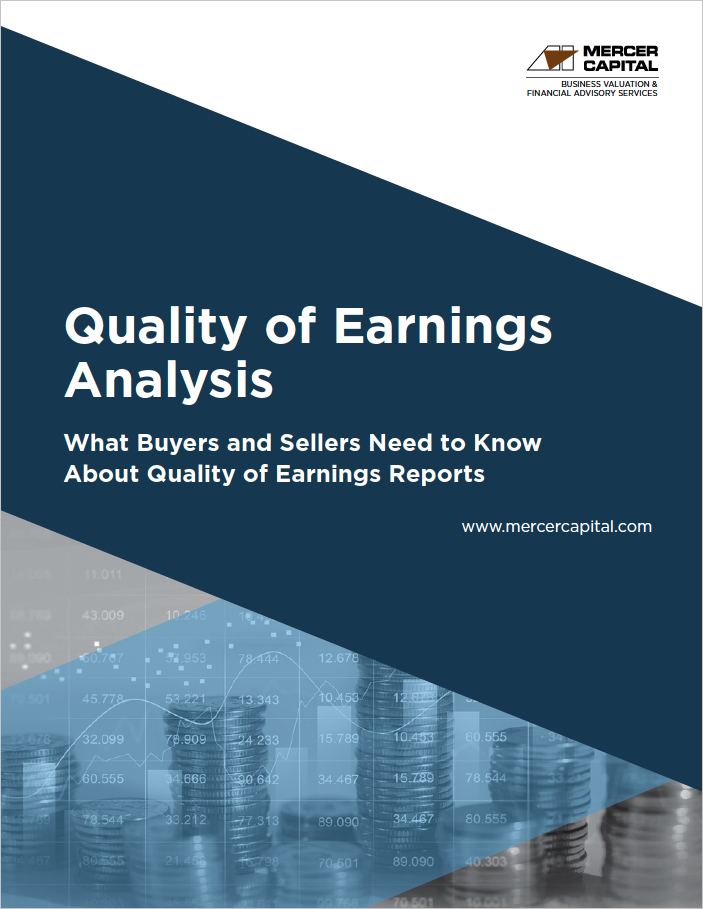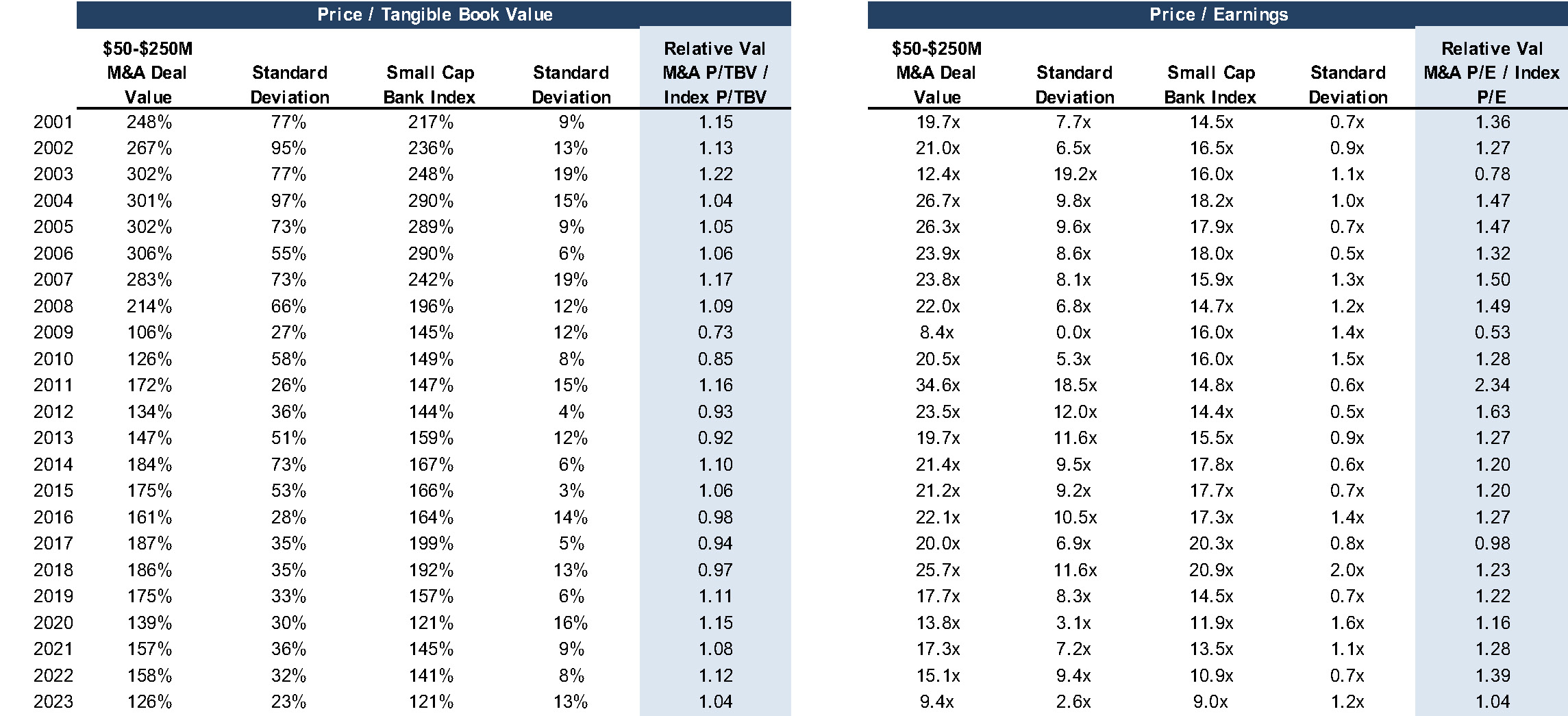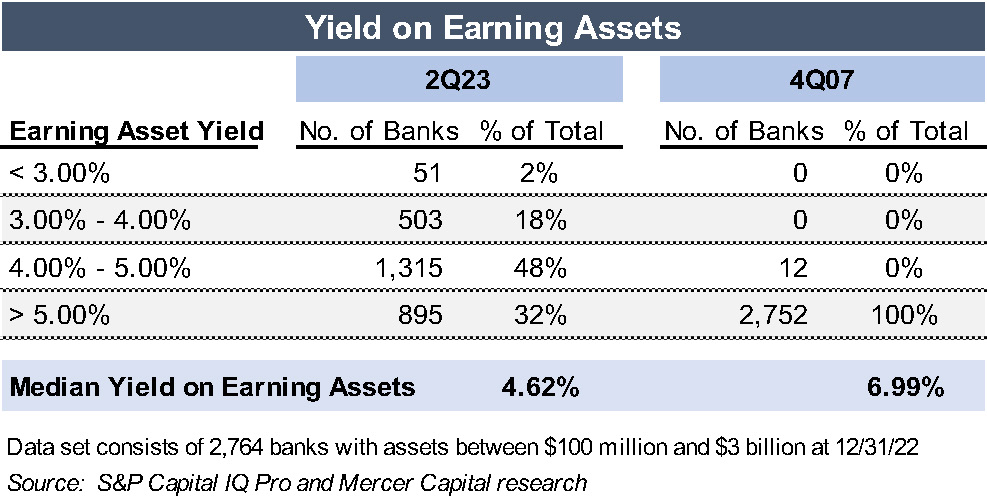Potential Impact of Baltimore Bridge Collapse on the Logistics Industry
It’s been hard to miss the news footage and video of the cargo ship Dali colliding with the Francis Scott Key Bridge across the Chesapeake Bay. The bridge collapse – as sudden as it is surprising – is another landmark in what has been a series of tumultuous years in the logistics industry. We recently wrote about global impacts on the supply chain, particularly East Coast ports, and this is another reminder about how unpredictable events can have a wide reach.
The Port of Baltimore
The Port of Baltimore is in the top twenty ports by volume in the United States and is the 5th largest port for foreign trade on the East Coast. The Washington Post estimates that the port handled over 50 million tons of foreign cargo with value in excess of $80 billion during 2023. The port is the 2nd largest exporter of coal from the U.S. (though still a relatively small player on a global scale) and is the largest port for imports of automobiles, sugar, and gypsum. Baltimore is also equipped to handle Neo Panamax ships passing through the Panama Canal.
Sharing the fortunes of several other East Coast ports of the last several years, the Port of Baltimore posted several records in 2023, including for the largest number of TEUs handled (1.1 million) and general cargo tons (11.7 million). Baltimore posts these growth records despite the overall decline in imports to the U.S. during 2022.
Potential Short-Term and Long-Term Impact
Short term impacts will include delays of cargo already in transit for East Coast ports, whether originally bound for Baltimore or not. Just as we saw chokepoints on the West Coast lead to a redistribution of cargo among ports, the loss of the Baltimore port for the foreseeable future will cause ripple effects throughout the industry.

Source: The Washington Post
Other East Coast ports will likely take up the bulk of cargo previously destined for Baltimore. In particular, soybean shipments are expected to transfer to Norfolk, Savannah, and Charleston, while containers are expected to be processed in either Philadelphia or Norfolk. In any case, the truck routes and rail cars that previously serviced Baltimore will need to be recentered on other ports.
However, this will be somewhat mitigated by global events that were already impacting East Coast ports—namely, the ongoing drought limiting capacity through the Panama Canal and the Houthi rocket attacks in the Red Sea, both of which had diverted some cargo away from East Coast ports prior to the bridge collapse.
An additional concern is the International Longshoreman’s Association contract, which covers port workers from Texas through the Northeast. The contract is set to expire in September 2024. Talks stalled in early 2023 before resuming again in February 2024.
The West Coast freight bottleneck that dominated transportation headlines in 2022 was brought on by labor disputes combined with a drastic increase in demand for shipping services due to COVID-fueled shopping. Conversely, the national freight market has been soft through 2023 and demand is not expected to rapidly escalate as it did a few years ago. This should limit long-term bottlenecks and chokepoints from forming on the East Coast.
Conclusion
Mercer Capital’s Transportation & Logistics team constantly watches the transportation industry and global events and economic factors that can impact the overall industry, the supply chain, or various aspects of transportation.
Mercer Capital provides business valuation and financial advisory services, and our transportation and logistics team helps trucking companies, brokerages, freight forwarders, and other supply chain operators to understand the value of their business. Contact a member of the Mercer Capital transportation and logistics team today to learn more about the value of your logistics company.
Essential Financial Documents to Gather During Divorce – Part 2
Documents Needed to Analyze Support and Need (A Lifestyle Analysis)
Prepared by Mercer Capital’s Family Law Services Team
In Part 1 of this series, we discussed the importance of hiring an expert and the documents needed to prepare the marital balance sheet including tax returns and a personal financial statement.
In this article, we discuss the documents needed for analyzing support and need, otherwise known as a Lifestyle Analysis or a Pay and Need Analysis.
Analyzing what would be a reasonable amount for alimony is based upon both a division of assets as of the divorce date (covered in Part 1 of this series) and expectations for future income and expense. We frequently perform a Lifestyle Analysis for divorcing parties. This analysis examines and documents each party’s sources of income and expenses. As noted in our article on Lifestyle Analysis, it is used in the divorce process to demonstrate the standard of living during the marriage and to determine the living expenses and spending habits of each spouse. It is typically a more in-depth analysis required in the divorce process and is prepared by an expert credentialed in forensics.
As part of the divorce proceedings, each party typically files a financial affidavit, which is simply an expected monthly budget post-marriage. The historical status quo, or lifestyle, usually serves as a basis for developing these expenses. However, two households going forward sometimes cannot be similarly supported by the historical marital budget. For example, a married couple with a mortgage provides shelter for both spouses whereas post-divorce, there will be an additional mortgage or rent expense. Sometimes the marital residence will be sold, and each party will live in accommodations more commensurate with what is affordable within the divorcing parties’ new budget.
Documents for Support Analysis or Alimony/Child Support (Comparing Marital Income vs. Budgeted Expenses)
While rent/mortgage is one of the largest monthly expenses, the financial affidavit will include a variety of categories including home, maintenance, vehicle, utilities, food costs, and other typical “fixed” or “shared” monthly expenses captured in a budget. Sometimes financial experts help with this process, while other times attorneys and clients gather and determine these budgets. Attorneys typically provide a template for monthly expenses, but clients may need to corroborate their entries with the following documents:
- Utility bills (cable, internet, electric, water, gas)
- Insurance (health, life, etc.) premiums
- Mortgage statement (“PITI” – which stands for principal, interest (both from fixed monthly mortgage payment), taxes and insurance)
- Credit card statements which may further break down:
- Groceries
- Gas
- Subscriptions (Netflix, Amazon Prime, etc.)
- Travel
- Meals & Entertainment
- Health & Wellness
- Medical
- Etc.
It’s important to note that these expenses, where possible, should reflect those of the divorcing spouses, not child-related expenses. Child expenses such as tuition, extra curriculars, etc. should be considered separately in the award of child support paid to the primary care-taker and/or spouse with lower income potential depending on the facts and circumstances of the case.
While understanding a couple’s expenses is important to determining alimony, reasonable expectations for future income is also very important. For a couple with a simple W-2 job, this analysis may be more straightforward. Still, there are many instances where income fluctuates from year-to-year based on bonuses or company performance, requiring more analysis and more documentation than what is provided on a W-2, 1099, or tax return. Helpful documents for determining income include:
- Bi-weekly or monthly paystubs
- Payroll registers
- 401k/ESOP statements detailing annual contribution levels
- Owner draws
- Documentation about restricted stock units, phantom stock, stock options, and other equity instruments
- Incentive-based compensation agreements such as bonus agreements
- Employment history
- Employment contracts
- Non-compete agreements
As noted above, the goal of this analysis is to determine ongoing earnings capacity. If a divorcing party was recently promoted where his/her compensation structure either increased or was materially changed (i.e. equity vs. W-2), a simple average of historical compensation likely will not be sufficient.
In many divorce cases, one spouse has taken on the primary responsibility of raising children. Depending on the facts and circumstances, a vocational expert may be needed to opine on the potential earning power of that spouse based on their experience, qualifications, education, credentials, and other pertinent information. While a credentialed financial expert should be able to make a reasonable determination for someone currently in the workforce, a specialized vocational expert may be required for a spouse who has not recently worked. All else equal, a higher earnings capacity for that spouse tends to reduce the “need” in determining alimony, and it becomes a more contested area in the process, which leads to the potential use of a vocational expert.
Tip for business owners: It is important to understand how much the party’s income is from services performed in his/her capacity as an executive versus how much of the income is a return on the capital invested in the business. How this gets analyzed in a Pay and Need Analysis can become complicated and is a hotly debated topic. Triers of fact may disagree on whether valuing the business also inherently considers some of this income, known as the “double dip.” Because officer compensation can be a key discussion within the valuation of a business, we will cover it in greater detail in a future part of this series.
Conclusion
A financial expert can help focus the scope of a divorce case, saving time and money throughout the process, particularly if brought in early to the process with ample time to assist with the various stages of the case. We make our engagements as efficient as possible, in hopes of reducing the need to update our analysis, which can drag out the process and lead to higher costs for clients.
For more information or to discuss your matter with us, please don’t hesitate to contact us.
Essential Financial Documents to Gather During Divorce Series
5 Reasons Sellers Need a Quality of Earnings Report
M&A deal flow was sidelined for much of 2022 and 2023, but the economy’s soft landing, stabilizing interest rates, and pent-up M&A demand are expected to compel buyers and sellers to renew their efforts in 2024 and beyond.
As deal activity recovers, sellers need to be prepared to present their value proposition in a compelling manner. For many sellers, an independent Quality of Earnings (“QofE”) analysis and report are vital to advancing and defending their asset’s value in the marketplace. And it can be critical to the ensuing due diligence processes buyers apply to targets.
The scope of a QofE engagement can be tailored to the needs of the seller. Functionally, a QofE provider examines and assesses the relevant historical and prospective performance of a business. The process can encompass both the financial and operational attributes of the business.
In this article, we review five reasons sellers benefit from a QofE report when responding to an acquisition offer or preparing to take their businesses to market.
1. Maximize value by revealing adjusted and future sustainable profitability.
Sellers should leave no stone unturned when it comes to identifying the maximum achievable cash flow and profitability of their businesses. Every dollar affirmed brings value to sellers at the market multiple. Few investments yield as handsomely and as quickly as a thorough QofE report. A lack of preparation or confused responses to a buyer’s due diligence will assuredly compromise the outcome of a transaction. The QofE process includes examining the relevant historical period (say two or three years) to adjust for discretionary and non-recurring income and expense events, as well as depicting the future (pro forma) financial potential from the perspective of likely buyers. The QofE process addresses the questions of why, when, and how future cash flow can benefit sellers and buyers. Sellers need this vital information for clear decision-making, fostering transparency, and instilling trust and credibility with their prospective buyers.
2. Promote command and control of transaction negotiations and deal terms.
Sellers who understand their objective historical performance and future prospects are better prepared to communicate and achieve their expectations during the transaction process. A robust QofE analysis can filter out bottom-dwelling opportunists while establishing the readiness of the seller to engage in efficient, meaningful negotiations on pricing and terms with qualified buyers. After core pricing is determined, other features of the transaction, such as working capital, frameworks for roll-over ownership, thresholds for contingent consideration, and other important deal parameters, are established. These seemingly lower-priority details can have a meaningful effect on closing cash and escrow requirements. The QofE process assists sellers and their advisors in building the high road and keeping the deal within its guardrails.
3. Cover the bases for board members, owners, and the advisory team and optimize their ability to contribute to the best outcome.
The financial and fiduciary risk of being underinformed in the transaction process is difficult to overcome and can have real consequences. Businesses can be lovingly nurtured with operating excellence, sometimes over generations of ownership, only to suffer from a lack of preparation, underperformance from stakeholders who lack transactional expertise, and underrepresentation when it most matters. The QofE process is like training camp for athletes — it measures in realistic terms what the numbers and the key metrics are and helps sellers amplify strengths and mitigate weaknesses. Without proper preparation, sellers can falter when countering an offer, placing the optimal outcome at risk. In short, a QofE report helps position the seller’s board members, managers, and external advisors to achieve the best outcome for shareholders.
4. Financial statements and tax returns are insufficient for sophisticated buyers.
Time and timing matter. A QofE report improves the efficiency of the transaction process for buyers and sellers. It provides a transparent platform for defining and addressing significant reporting and compliance issues. There is no better way to build a data set for all advisors and prospective buyers than the process of a properly administered QofE engagement. This can be particularly important for sellers whose level of financial reporting has been lacking, changing, outmoded due to growth, or contains intricacies that are easily misunderstood.
For sellers content to work their own deals with their neighbors and friendly rivals, a QofE engagement can provide some of the disciplines and organization typically delivered by a side-side representative. While we hesitate to promote a DIY process in this increasingly complicated world, a QofE process can touch on many of the points that are required to negotiate a deal. Sellers who are busy running their businesses rarely have the turnkey skills to conduct an optimum exit process. A QofE engagement can be a powerful supporting tool.
5. In one form or another, buyers are going to conduct a QofE process – what about sellers?
Buyers are remarkably efficient at finding cracks in the financial facades of targets. Most QofE work is performed as part of the buy-side due diligence process and is often used by buyers to adjust their offering price (post-LOI) and design their terms. It is also used to facilitate their financing and satisfy the scrutiny of underlying financial and strategic investors. In the increasing arms race of the transaction environment, sellers need to equip themselves with a counteroffensive tool to stake their claim and defend their ground. If a buyer’s LOI is “non-binding” and subject to change upon the completion of due diligence, sellers need to equip themselves with information to advance and hold their position.
Conclusion
The stakes are high in the transaction arena. Whether embarking on a sale process or responding to an unsolicited inquiry, sellers have precious few opportunities to set the tone. A QofE process equips sellers with the confidence of understanding their own position while engaging the buy-side with awareness and transparency that promotes a more efficient negotiating process and the best opportunity for a favorable outcome. If you are considering a sale, give one of our senior professionals a call to discuss how our QofE team can help maximize your results.
WHITEPAPER
Quality of Earnings Analysis
For buyers and sellers, the stakes in a transaction are high. A QofE report is an essential step in getting the transaction right.
Worldwide Impacts on Marine Shipping – Q4 2023
We discussed reshoring and nearshoring trends a bit in the last Value Focus Transportation and Logistics newsletter. There’s been some developments on that front, especially as it relates to the ongoing battle between East Coast and West Coast ports.
As we mentioned last time, a variety of pandemic-related and regulatory issues resulted in long delays at California ports, the traditional import location for the majority of goods from East Asia. Many carriers shifted their import handling to East Coast ports – with the port of Savannah being one of the biggest winners. Georgia has posted three straight record–setting years for exports. A study by Cushman Wakefield that ran through October 2023 shows that volumes at East Gulf Ports exceeded West Coast volumes for the majority of 2022 and 2023. However, early results indicate the West Coast ports grew faster than East Coast ports in November and December 2023, and there are a couple of reasons behind that.
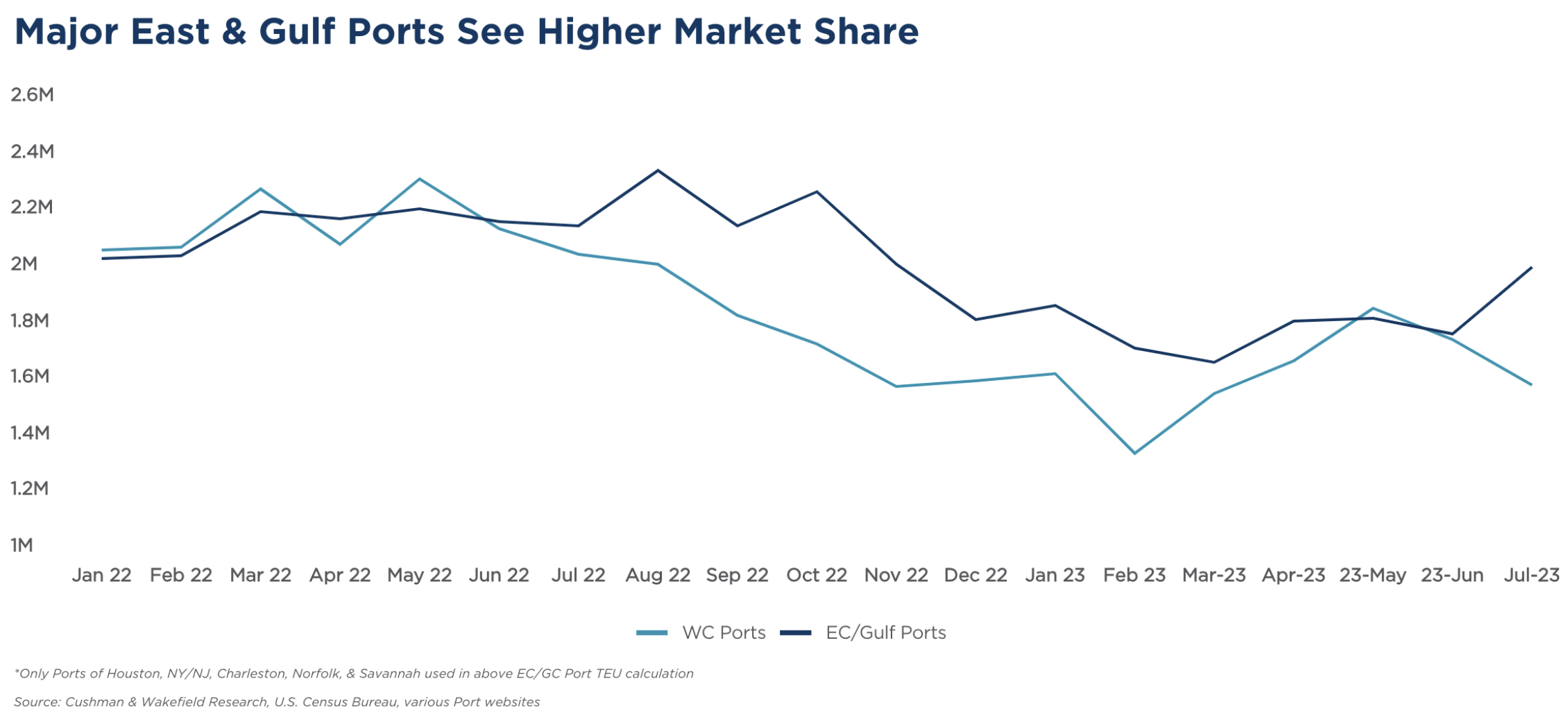
(click here to expand the image above)
The El Niño weather event has hit the Panama Canal hard. Under normal conditions, between 36 and 38 ships per day will make the transit. Due to the worst drought Panama has experienced in over 70 years, the Canal Authority began reducing the number of ships passing through on a daily basis in July 2023. In February 2024, the Canal Authority reduced the total number of ships to 18 per day.
Meanwhile, approaching from the other direction has been made harder by attacks on vessels in the Red Sea. About one-fifth of freight reaching East Cost ports travels through the Red Sea and the Suez Canal. Shippers continuing to use the Suez canal route will face higher insurance charges, while shippers opting to go around the Cape of Good Hope can expect to add at least a week to transit times. More recently, the first fully sunk ship from the conflict also disrupted underwater data cables. So far, analysts have had mixed opinions on the overall impact that will arise from the Houthi attacks.
Between Red Sea disruptions and climate issues in Latin America the impact of worldwide current events on marine logistics cannot be ignored.
Themes From the 2024 Acquire or Be Acquired Conference
For those who haven’t been to Bank Director’s Acquire or Be Acquired conference (AOBA) before, it is a two-and-a-half-day conference in the desert (Phoenix) that typically includes great weather, golf at the end, and has broadened over the years to focus on a combination of M&A, growth, and FinTech strategies.
Cautious Optimism
While the 2024 version of AOBA included a number of discussions around headwinds facing the sector, there was optimism for 2024 when compared to 2023. For example, the banking audience was asked during the conference: How do you feel about 2024 compared to your experience in 2023? ~90% responded that they felt more optimistic about 2024 when compared to 2023. Additionally, several sessions noted that optimism exists for an uptick in deal activity in the second half of 2024.
Traditional Bank M&A Tailwinds and Headwinds
While the turbulence and potential headwinds for bank M&A that slowed deal activity in 2023 continue to persist at the outset of 2024, traditional bank M&A remained a much discussed topic at the 2024 AOBA conference. Discussions focused on the nuts and bolts of M&A from valuation to due diligence to structuring and ultimately to integration. While certain themes change and evolve, the strategy to achieve greater scale and growth through M&A and to enhance efficiency and profitability that create value over the long run, persist. The challenging M&A landscape could present an opportunity for acquirers with the balance sheet and capacity to engage in a transaction, and the silver lining for those acquirers may be less competition for sellers as some buyers focus internally during the challenging operating environment.
Balance Sheets in Focus
There were definitely more sessions this year discussing balance sheets. A number of sessions noted that one key to dealmaking in the current environment was managing the balance sheet, and several discussed the impact of fair value marks on sellers and pro forma combined balance sheets and the impact on deal activity. For acquirers, a strong balance sheet and capital level can position their institution to be able to take advantage of the current deal environment. For sellers, having a balance sheet that is less impacted from the fair value marks to loans and bonds and with more valuable deposits enhances their attractiveness to potential acquirers. In one session, my colleagues Jeff Davis and Andy Gibbs discussed the impact of taking a loss today on low-coupon bonds that are worth less than the current market price versus holding the bonds to maturity on the value of a bank’s equity. They also reviewed an intermediate strategy referred to as the installment method.
Deposits, Deposits, Deposits
Consistent with discussions around the balance sheet, the interest rate environment, and impact on the banking industry & M&A, discussions about deposits came up often. These discussions covered strategies to retain business or consumer deposits, the attractiveness of core deposits for acquirers in the current environment, how to grow deposits organically (some of the largest banks are even turning back the clock and building branches again), trends in core deposit intangible valuations, and how to provide your customers with the technology and digital banking solutions to onboard and retain deposits more efficiently. One question discussed in several sessions that will be interesting to see the answer to in 2024 was: Has the cost of funds peaked?
Technology Brings Opportunities
Over the last few years, technology has been an increasing topic discussed during sessions of AOBA. Technology topics discussed included leveraging payments to enhance retail and small business banking, using software and/or digital banking to more efficiently make loans and/or open deposit accounts and best practice for developing and managing risk of FinTech partnerships. Even AI, the market’s favorite topic of 2024, was discussed. A consensus on how best to leverage AI in banking has not yet emerged in my view but topics discussed included leveraging AI to enhance loan growth or efficiency of common tasks in the back office. Traditional M&A has historically focused on the potential diversification benefits of combining loan portfolios, deposit portfolios, and geographic footprints but increasingly the tech stacks of buyers and sellers are being compared to see what diversification benefits exist and what the cost may be to combine the tech stack after closing.
Technology Also Brings Potential Risks
One challenging aspect of technology for banks was how best to balance the potential benefits of technology with the risks inherent in them, particularly new technologies and FinTech partnerships. Tech-forward banks and their valuations were also discussed. As we have noted in the past, this tech-forward bank group has seen increased volatility in market performance than their peers as the market digests some of the tech-oriented business models (such as banking-as-a-service) and weighs the potential for higher growth and profitability against the potential risk of these business models and regulatory scrutiny.
Non-Traditional Deals
Similar to traditional bank deals, bank acquisitions in non-traditional areas like specialty finance, insurance, and asset management have been modest and challenging given the difficult operating environment, higher cost of debt, and opportunity cost of excess liquidity. However, there were some discussions around best practices and lessons learned from specialty finance transactions and that additional opportunities may emerge as non-bank lenders also deal with the challenging funding and interest rate environment. Additionally, Truist recently announced the sale of its insurance business to book a gain, focus on core banking, and enhance capital. The announced bank acquisitions by credit unions and private investors also illustrate that non-traditional deals remain a part of a bank’s strategic playbook.
Conclusion
We look forward to discussing these issues with clients in 2024 and monitoring how they evolve within the banking industry over the next year. As always, Mercer Capital is available to discuss these trends as they relate to your financial institution, so feel free to call or email.
Essential Financial Documents to Gather During Divorce – Part 1
Documents Needed to Prepare the Marital Balance Sheet
Prepared by Mercer Capital’s Family Law Services Team
We have written in the past about the benefits of hiring an expert in family law cases, whether it’s expected to settle or go to trial.
In this multi-piece series, we want to provide you with a resource that will assist you and your clients during one of the most difficult times in their lives, both emotionally and financially, and inspired by a recent post we read.
Often, one spouse takes on the primary responsibility of paying bills, filing taxes, and various other management of household finances. During divorce, this can lead the other spouse to feel lost, or at least at a disadvantage.
Mercer Capital has compiled a list of financial documents that are typically needed in the divorce process and decoded common financial terms helpful to attorneys and their clients.
Financial experts can assist in determining the relevant documents based on the facts and circumstances of the case, which can reduce the burden of hunting down extraneous documents. Most financial documents fall into one (or multiple) of the following categories:
- Determining the value of the marital estate (aka marital balance sheet or net worth), and the individual assets and liabilities which comprise such
- Determining income and expenses for spousal and/or child support (akin to an income statement or budget)
- Determining the value of business(es)
- Providing support for forensic services
One of the preliminary financial documents requested, unsurprisingly, is tax returns. We’ve written about this in Mercer Capital’s Navigating Tax Returns: Tips and Key Focus Areas for Family Law Attorneys and Divorcing Individuals/Business Owners, which is a great resource for understanding and reviewing tax returns, particularly for purposes of divorce.
Tax returns report income received from various sources, which is beneficial for various financial analyses, but are also beneficial in constructing the marital balance sheet. Tax returns provide insight into other financial situations such as passive income and even hidden assets.
However, tax returns are dense and may not give as granular of detail as the source documents provided to a CPA who might prepare the returns. For example, the return may not break down W-2 wages by salary/bonus, which is important to making reasonable ongoing compensation determinations. So, while it makes sense that tax returns are a preliminary financial document, they may not be the primary source for information, depending on facts and circumstances.
Another key document to request in the divorce process is a personal financial statement (“PFS”), which is more commonly available to business owners. This is often submitted to a financial institution like a bank when seeking a loan. While usually required for a business loan, it can also be used for a mortgage, and may be required annually by the bank. The PFS provides assets, liabilities and sources of income and assets, which can shortcut the process of “finding” all assets and sources of income for the couple when building the marital balance sheet or determining income for support purposes.
A PFS can also be helpful if a spouse has opined on the value of their business. When applying for a loan, a business owner might be incentivized to view the business through rose-colored glasses. Sometimes, the opposite may be true in divorce, where a divorcing business owner retains the business post-divorce. The term “divorce recession” may come to mind, and the term exists for a reason. As with everything, facts and circumstances matter. The value of a business is not stagnant over time, and the value of a company may look different following a record year as opposed to its worst year. As one of our colleagues likes to say, while the value listed on a PFS is not the data point, it is one of many data points that valuation professionals ought to consider when evaluating a company and preparing for the due diligence interview.
Documents for Marital Balance Sheet (Dividing Up Net Estate)
In most divorce cases, either the expert or attorney will need to prepare a marital balance sheet, or statement of net worth or net estate; this may be referred to differently depending on state and jurisdiction. Divorcing couples may reasonably disagree about the value of the assets and liabilities that they own, and they may further disagree on division of these items. Experts can assist both in developing the list of assets and liabilities and reviewing division scenarios. Our job is easier once we receive documents including statements with contemporaneous balances. This includes:
- Bank statements (checking and savings accounts)
- Any safety deposit box and contents
- Investments/Brokerage accounts statements
- 401k, IRA, and other retirement account statements
- 529 plans (good to be aware of, but commonly not analyzed as these are “separate” assets for the benefit of children)
- List of real estate owned – these may require current appraisals if they were not recently purchased
- List of vehicles, boats, jewelry, etc.
- Airline miles
- List of all business interests
- Investments that have active interest in
- Trusts, wills, etc.
- Mortgage statement
- Credit card statements along with list of credit cards and accounts
- Student Loan statements
- Other debt statements
- Tax refunds/liabilities
- Credit reports
- Insurance (home, life, auto, other assets, etc.)
- Others may be needed depending on circumstances
Conclusion
A financial expert can help in many ways, including focusing the scope of a divorce case, particularly if brought in early to the process with ample time to assist with the various stages of the case. This can reduce duplicative requests and can provide an understanding of why various documents are necessary.
A competent financial expert will be able to define and quantify the financial aspects of a case and effectively communicate the conclusion.
For more information or to discuss your matter with us, please don’t hesitate to contact us.
Essential Financial Documents to Gather During Divorce Series
5 Reasons Buyers Need a Quality of Earnings Report
After sitting on the sidelines for much of 2022 and 2023, the prospect of Fed rate cuts may lure buyers back onto the field in 2024.
And when deal activity heats back up, due diligence will be as critical to buyers as ever. For many buyers, a quality of earnings (“QofE”) report is a cornerstone of their broader diligence efforts.
For businesses, an acquisition that goes sour can negatively affect family wealth for decades to come. Obtaining a thorough QofE report as part of deal diligence can help business directors avoid such a misstep. In this article, we review five reasons business directors need a QofE report before approving an acquisition.
1. Avoid overpaying for earnings that aren’t sustainable.
Audited financial statements provide assurance that the past performance of the target company is faithfully represented. However, successful acquirers are focused on the future, not the past. A thorough QofE report helps buyers extract what truly sustainable performance is from the welter of the target’s historical earnings. Paying for historical earnings that don’t materialize in the future is a recipe for sinking returns on invested capital. QofE reports analyze historical earnings for adjustments that convert historical earnings to the pro forma run rate earnings that make an acquisition worthwhile.
2. Identify opportunities for cost savings in the target’s expense base.
The detailed analysis of cost of sales and operating expenses in a QofE report can uncover opportunities for acquirers to boost margins at the target through cost-saving initiatives. By observing trends in headcount by function, occupancy, and other components of operating expense, buyers can identify redundancies and develop strategies for enhancing post-acquisition cash flow from the target.
3. Find revenue synergies with your existing business.
A thorough QofE report is not just about expenses. Observing revenue trends by product and business segment, coupled with analysis of customer churn data, can help buyers better understand how the target “fits” with the existing business of the buyer, which can open up strategies for fueling revenue growth in excess of what either company could accomplish on a standalone basis. Armed with a better understanding of opportunities for revenue synergies, buyers can move to the closing table more confident of the upside to be unlocked through the transaction.
4. Clarify working capital needs of the target.
Incremental working capital investment is the silent killer of transaction return on investment. A thorough QofE report will move beyond the income statement to evaluate seasonal trends in the core components of net working capital. Doing so helps buyers plan adequately for the ongoing working capital requirements they will need to fund out of post-acquisition earnings. Working capital analysis in the QofE report also helps buyers negotiate appropriate working capital targets in the final purchase agreement.
5. Assess capital expenditure needs at the target.
Not every dollar of EBITDA is equal. EBITDA multiples are a function of risk, growth, and capital intensity. Buyers cannot afford to overlook capital intensity when evaluating targets. A thorough QofE report examines historical trends in capital expenditures and fixed asset turnover to help buyers better discern the prospective capital expenditure needs of the target and how those needs influence the transaction price and prospective returns.
Conclusion
For businesses contemplating an acquisition, the stakes are high. You can’t eliminate risk from an M&A transaction but obtaining a thorough QofE report on the target can help directors avoid mistakes and increase the odds of a successful deal. If you are considering an acquisition, give one of our senior professionals a call to discuss how our QofE team can generate Insights That Matter for your diligence team.
WHITEPAPER
Quality of Earnings Analysis
For buyers and sellers, the stakes in a transaction are high. A QofE report is an essential step in getting the transaction right.
Pay Versus Performance: What’s New in Year 2?
Executive Summary
- The 2024 proxy season marks Year 2 under the SEC’s new Pay Versus Performance disclosure framework for public companies.
- The SEC issued additional guidance over the last year which clarified the requirements and commented upon registrants’ proxy filings from 2023. We discuss several of these items pertaining to valuation and equity-based compensation in this article.
- Newly public companies and those private companies aspiring to list in the future should be aware of the disclosure and valuation requirements related to Compensation Actually Paid for senior executives.
- With respect to equity-based awards such as stock options and performance shares with market conditions, the rules continue to point to alignment with ASC 718 and require the disclosure of any significant change in valuation techniques and assumptions.
- Registrants and their advisors should pay particular attention to the impact of changes in key assumptions on the fair value of equity awards, including volatility, realized performance, and changes in the composition of total shareholder return (TSR) peer groups.
Introduction
The SEC’s Pay Versus Performance disclosure rules introduced significant new valuation requirements related to equity-based compensation paid to company executives. As the 2024 proxy season gets underway, what lessons have been learned and what guidance has the SEC provided to registrants? We discuss some of the SEC’s recent Compliance & Disclosure Interpretations and share some best practices as companies gear up for Year 2 of the new Pay Versus Performance framework.
To recap how we got to this point, the new disclosures were mandated by the Dodd-Frank Wall Street Reform and Consumer Protection Act and were originally proposed by the SEC in 2015. These rules added a new item 402(v) to Regulation S-K and are intended to provide investors with more transparent, readily comparable, and understandable disclosure of a registrant’s executive compensation. The new provisions apply to all reporting companies other than (i) foreign private issuers, (ii) registered investment companies, and (iii) emerging growth companies.
The rules apply to any proxy and information statement where shareholders are voting on directors or executive compensation that is filed in respect of a fiscal year ending on or after December 16, 2022. As such, the vast majority of registrants were required to include these disclosures in their 2023 proxy statements, with scaled-down disclosures for smaller reporting companies.
For a more technical discussion of the rules, see our earlier article 5 Things to Know About the SEC’s New Pay Versus Performance Rules.
Valuation-Related Takeaways from the SEC Guidance
The Pay Versus Performance rules require registrants to disclose the fair value of equity awards to certain senior executives in the year granted and to report changes in the fair value of the awards until they vest. Practically speaking, this means that it is necessary to measure the year-end fair value of all outstanding and unvested equity awards under a methodology consistent with what the registrant uses in its financial statements (e.g., ASC 718, Compensation – Stock Compensation).
In 2023, the SEC issued a series of Compliance & Disclosure Interpretations (C&DIs) relating to the Pay Versus Performance disclosure requirements. The roughly 30 C&DIs issued in 2023 are structured in a question-and-answer format. While the questions address many different aspects of the requirements, we focus our summary on those that pertain to valuation-related issues. In the sections that follow, we summarize each question and answer for clarity.
Question 128D.14 (Treatment of Awards Granted Prior to a Restructuring or Spin-Off)
Should awards granted in fiscal years prior to an equity restructuring, such as a spin-off, that are retained by the holder be included in the calculation of executive compensation actually paid?
Answer: Yes. All stock awards and option awards that are outstanding and unvested at the beginning of the covered fiscal year or are granted to the principal executive officer and the remaining named executive officers during the covered fiscal year should be included in the CAP table.
Question 128D.15 (Using Private Company Prices for Newly Public Companies)
For a newly public company (e.g., IPO or SPAC) complying with the proxy statement rules for the first time, should the change in fair value of awards granted prior to IPO be based on the fair value of those awards as of the end of the prior fiscal year for purposes of determining executive compensation actually paid?
Answer: Yes. For outstanding stock awards and option awards, the calculations required by Regulation S-K should be determined based on the change in fair value from the end of the prior fiscal year. The fair value of these awards should not be determined based on other dates, such as the date of the registrant’s IPO. This means that prior private company valuations (such as for 409A or ASC 718) could come into play when preparing future Pay Versus Performance disclosures.
Questions 128D.16-17 (Inclusion of Market Conditions in Fair Value)
How should awards with a market condition consider that condition in determining whether the applicable vesting conditions have been met in performing the CAP calculations?
Answer: The effect of a market condition should be reflected in the fair value of share-based awards with such a condition. Until the market condition is satisfied, registrants must include in executive compensation actually paid any change in fair value of any awards subject to market conditions. Similarly, registrants must deduct the amount of the fair value at the end of the prior fiscal year for awards that fail to meet the market condition during the covered fiscal year if it results in forfeiture of the award. However, awards that remain outstanding and have not yet vested should not be considered forfeited.
Question 128D.20 (Use of a Different Valuation Technique)
Can a registrant use a different valuation technique for Pay Versus Performance calculations than what was used for grant date fair value?
Answer: Yes, as long as the valuation technique would be permitted under ASC 718, including that it meets the criteria for a valuation technique and the fair value measurement objective. For example, another valuation technique might provide a better estimate of fair value subsequent to the grant date. The rules require disclosure about the assumptions made in the valuation that differ materially from those disclosed as of the grant date. A change in valuation technique from the technique used at the grant date would require disclosure of the change and the reason for the change if such technique differs materially.
Question 128D.21 (Use of Non-GAAP Methods or Shortcuts)
Is it ever acceptable to value stock and/or option awards as of the end of a covered fiscal year based on methods not prescribed by GAAP?
Answer: No. The fair value of equity awards must be computed using methodology and assumptions consistent with ASC 718. For example, the expected term assumption to value options should not be determined using a “shortcut approach” that simply subtracts the elapsed actual life from the expected term assumption at the grant date. Similarly, the expected term for options referred to as “plain vanilla” should not be determined using the “simplified” method if those options do not meet the “plain vanilla” criteria at the re-measurement date, such as when the option is now out-of-the-money.
Assumptions to Watch in Year 2 Fair Value Disclosures
The procedures used to calculate fair value vary depending on the type of equity award. For stock options and stock appreciation rights (SARs), fair value is often calculated using a Black-Scholes or lattice model. When rolling prior grant valuations forward, care should be taken to ensure that the expected term appropriately considers moneyness of the options at the new date.
Performance shares and performance share units often include a performance condition (e.g., the award vests if revenues increase by 10%) or a market condition (e.g., the award vests if the registrant’s total shareholder return over a three-year period exceeds its peer group by at least 5%). The performance condition will require updated probability estimates at year-end and at the vesting date. Awards with market conditions are typically valued using Monte Carlo simulation and so a reassessment at subsequent dates using a consistent simulation model with updated assumptions will be necessary. For awards with market conditions, key assumptions to watch in Year 2 updates include:
Volatility – The volatility input should be updated to match the remaining term of the award. If the award is benchmarked to an index or group of peer companies, then the volatility (and correlation factor) for the benchmark should also be reevaluated. Shorter terms might also mean that forward-looking option-implied volatility could be more appropriate than historical approaches.
Realized Performance – When updating the fair value of a three-year award after one year of performance, one-third of the ultimate return (and potential payoff) is already locked in. For companies whose stocks have performed well (either individually or against their peer group), this could lead to a substantial increase in the fair value of the award. On the other hand, a company whose stock price has lagged its peer group could see the value of the award decline drastically, with little likelihood of favorable outcomes possible in the simulation model.
Relative TSR Peer Group Changes – For awards that link payouts to the performance of a group of peer companies or an index, some of the peers may have been acquired or merged since the grant date. The plan documentation will often describe the steps to be taken when the composition of the peer group changes or there is a change in the benchmark index. A different group (or number) of companies will affect the correlation assumption as well as the percentile calculations in a ranked plan.
These are just a few of the assumptions used in the valuation of equity awards. Ultimately, the valuation professional should assess the concluded values for reasonableness and be able to explain why the fair value moved as it did. This understanding provides the link to the calculation of Compensation Actually Paid (and the company’s explanation for it) in the Pay Versus Performance disclosures.
Summary and Next Steps
With Year 2 of the Pay Versus Performance framework underway, registrants and their advisors now have an understanding of what is expected. Further, the SEC’s additional guidance clarified several areas of potential confusion around the valuation of equity awards with market conditions and situations faced by newly public companies. Companies should pay particular attention to the impact of changes in key assumptions on the fair value of equity awards, including volatility, realized performance, and changes in the composition of total shareholder return (TSR) peer groups.
The complexity of implementing the Pay Versus Performance rules in Year 2 will vary by firm. We have already assisted clients with the transition from the initial Year 1 implementation to a roll-forward of previously-valued equity awards. And we certainly understand how the disclosure rules can seem daunting for those new firms who will be complying with the rules for the first time. Ultimately, the individual equity award characteristics will determine the complexity of the valuation process and the number of valuations that need to be performed.
If you have questions about the valuation of equity awards and how they are incorporated into the Pay Versus Performance disclosure framework, please contact a Mercer Capital professional.
Stock-Based Compensation in Volatile Markets
Employee, Management, and Investor Perspectives
Executive Summary
- Over the past decade stock-based compensation (SBC) gained widespread popularity as a way to reward employees while conserving cash.
- Turmoil in the stock market during 2022 resulted in employees seeing diminishing value in SBC and investors questioning its aggressive use.
- In this article, we discuss how market volatility can affect employee, management, and investor perspectives on SBC.
For the most part, we are all familiar with the pitch for stock-based compensation (SBC). For employees, SBC supplements cash compensation with equity ownership in the employer company. Employees get to share in the upside of the company’s growth and success, aligning their interests with that of the company and other shareholders. For employers, SBC is a cash-efficient way to finance operating expenses. SBC can be particularly beneficial for startups or development-stage companies looking to compete for top talent by trading future growth prospects for current cash outlay. Further, SBC can assist with employee retention, as the shares or options granted through SBC arrangements vest over a number of years.
Everyone Seems to Agree SBC Is Good
Indeed, companies across many sectors appear to have been increasingly convinced of the benefits of SBC in the period following the financial crisis. The following charts illustrate SBC expense trends among S&P 500 companies in certain sectors between 2010 and 2022.
Overall, reported SBC for companies in the S&P 500 grew more than 10% annually between 2010 and 2022, reaching a total of $192 billion in 2022 (approximately 1.2% of revenue). Technology-focused companies, many of whom graduated from the startup stage, are among the most prolific users of SBC. The communication services sector reported $57 billion in SBC expenses in 2022, an almost 13-fold increase since 2010. The information technology sector reported the largest SBC expenses in 2010 and remained among its more prominent users in 2022. But the use of SBC has proliferated beyond the technology-focused companies, as well. For example, reported SBC as a proportion of revenue increased more than four times between 2010 and 2022 for the consumer discretionary sector.
Some sectors were holdouts, however. Reported SBC expenses by companies in the energy sector grew at a relatively paltry 3.8% annually between 2010 and 2022.
SBC Expense Trends Among S&P 500 Companies
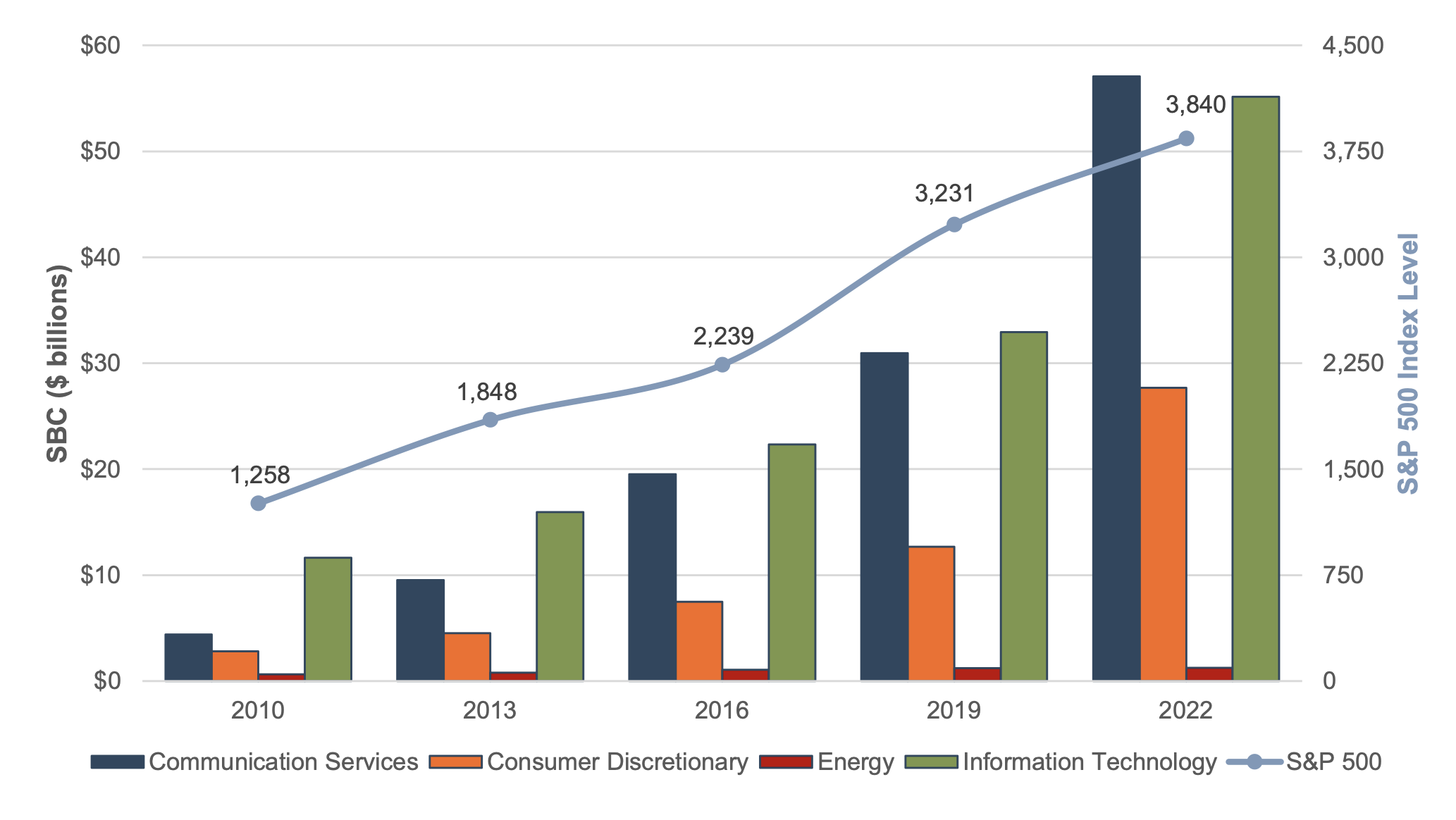
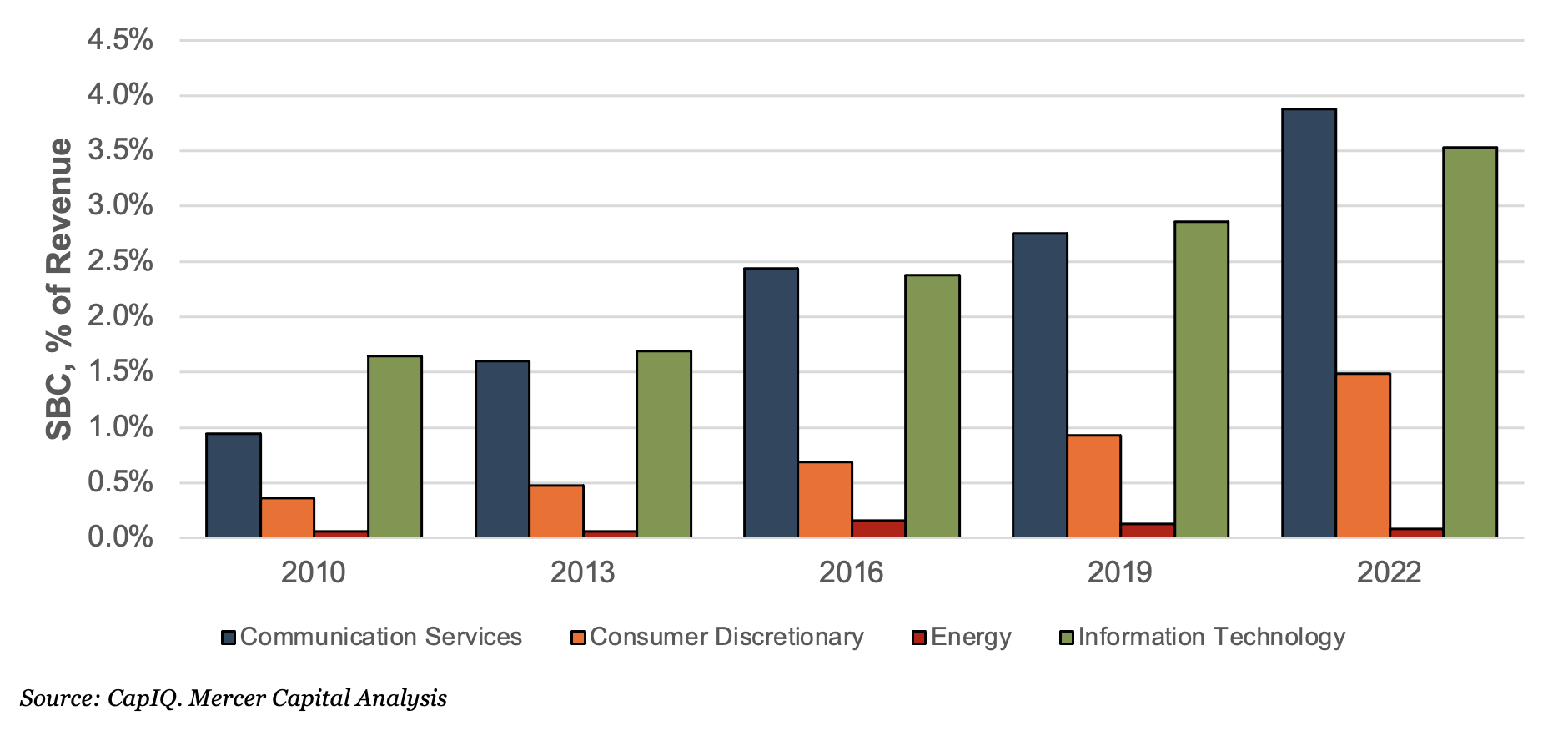
Stocks Go Up, Stocks Go Down
So, has a consensus been reached regarding the benefits of SBC? Not quite. Until 2022, the period after the financial crisis had been marked by sustained gains in the equity markets. The S&P 500 took a tumble during 2022 (falling approximately 20% during the year) before recovering some in 2023. As it relates to SBC, it would appear that when stock prices go up, all stakeholders are similarly happy. When stock prices fall, different stakeholders are unhappy in their own ways.
S&P 500 Relative Performance (June 30, 2021 = 1)

Employee Perspective: Underwater SBC
During 2022, employees were vocal about the diminishing values of the SBC they had received in the past.
Unlike cash compensation, the value of SBC can go up or down over the holding period. For example, say an employee was granted 1,000 restricted stock units (RSUs) in Company X that vest over a 4-year period, when the stock price was $225 per share. At grant, the employee would likely believe she had received $225,000 in compensation, save for a potential haircut to reflect the likelihood of vesting. If one year after grant, Company X’s stock drops 16.7% (similar to the draw down in the S&P 500 between July 2021 and mid-October 2022) to $187 per share, the employee could feel shortchanged by about $37,575.
Also, unlike cash compensation, SBC is usually a levered instrument. Obviously, leverage magnifies gains in the good times and losses in the bad times. As another example, say an employee is granted 1,000 stock options, which vest in 3 years, in Company Y with a strike price of $150 per share (current share price of Company Y’s stock). If one year after the grant, Company Y’s stock price rises to $161 per share (7% increase), the stock options would be “in the money” and the employee would be happy with the $10,500 potential gain on the bundle of stock options. However, if Company Y’s stock price takes a hit and declines 16.7% to $137 per share, the stock options would be “underwater” and would provide no intrinsic value to the employee. If the Company’s stock price does not recover to a price higher than $150 by the end of year 3, these options would expire worthless and the employee would realize no benefit.

Management’s Dilemma: Repricing or Additional Issuances
As the examples above have demonstrated, when markets decline, the value of SBC can fall or even become zero.
This leave managers with a difficult choice. Employers could issue more SBC to make up for the decline in value of previously awarded SBC. Or companies could elect to re-price previously-granted employee stock options. Repricing employee stock options entails a company modifying the terms of the options by reducing the strike price or extending the exercise date (presumably allowing time for the company’s stock price to recover). Managers fear that if they do not re-price or issue additional SBC, key employees may not be motivated and may seek greener pastures. Re-pricing prior grants or issuing additional SBC, however, is an administrative burden. These maneuvers also worsen the terms of financing the managers would have believed they obtained for (a portion of the) operating expenses when the SBC grants were made in the first place.
Investor Concerns: Dilution
Investors, for their part, can also feel aggrieved about the aggressive use of SBC, especially when stock prices are down. SBC conserves cash at the grant date but could result in future shareholder dilution. Consider the case of Peloton, which reported $405 million in stock-based compensation expense (14% of revenue) during fiscal 2023. While Peloton did not have to pay its employees an additional $405 million in cash during the year, SBC represents significant potential dilution for its shareholders. Peloton reported that it had 42.9 million in outstanding employee stock options and 27.2 million in RSUs as of June 30, 2023. The total number of shares outstanding at that date was 356.7 million. If all the RSUs and stock options vested and were exercised immediately, Peloton’s share count would increase by approximately 20%, significantly diluting other shareholder’s ownership. The issue of shareholder dilution can be further exacerbated when stock prices decline. At lower stock prices, a company will have to issue more shares to employees to provide the same dollar-level of SBC.
Conclusion
SBC serves as a powerful tool for motivating employees and retaining talent while conserving cash but can also be difficult to manage during periods of volatile stock prices. Striking the right balance between rewarding employees and addressing other stakeholder concerns is essential to maintain the relevance and usefulness of SBC programs. Mercer Capital’s valuation experts assist in the measurement of grant-date fair value of equity-based compensation across a variety of industries for ASC 718 and tax compliance. Call us – we can help you evaluate various equity compensation structures and adjustment mechanisms, and provide a reliable opinion regarding grant date fair value.
Observations from a Buy-Sell Agreement Gone Bad
How to Increase the Value of a Non-Controlling Interest in a Closely Held Business by 338% with No Money Down
A Matter of Life (Insurance) and Death
A buy-sell agreement among family shareholders should provide clear instructions for how the company’s stock is to be valued upon the occurrence of a triggering event, such as the departure or death of a shareholder. The United States Court of Appeals for the Eighth Circuit recently heard Thomas A. Connelly, in his Capacity as Executor of the Estate of Michael P. Connelly, Sr., Plaintiff-Appellant v. United States of America, Department of Treasury, Internal Revenue Service, Defendant-Appellee. The Eighth Circuit court affirmed a district court decision that concluded that life insurance proceeds received by a company triggered by a shareholder’s death should be included in the valuation of the company for estate tax purposes.[1]
Connelly is an estate tax deficiency case dominated by two themes: (i) the treatment of life insurance in the valuation of stock of a private company when a shareholder dies and (ii) the consequences of executing a buy-sell agreement that fails to meet the requirements under the Internal Revenue Code, Treasury regulations, and applicable case law, for purposes of controlling the valuation of a closely held company.[2] Using Connelly as a backdrop, we first demonstrate how opposing applications of life insurance proceeds received upon the death of a shareholder impact a company valuation. We then offer observations from a study of the Connelly buy-sell agreement from a valuation perspective that private business owners and their advisors should mind when drafting, reviewing, and amending buy-sell agreements.
The Stock Purchase Agreement
Crown C Supply Company, Inc. is a roofing and siding materials company founded in 1976 and headquartered in St. Louis, Missouri.[3] Crown C (an S corporation) and brothers Michael, Thomas, and Mark Connelly originally entered into a stock purchase agreement (“SPA”) on January 1, 1983. Mark’s interest in Crown C was terminated prior to the stock purchase agreement being amended and restated on August 29, 2001.[4] Crown C had 500 shares of common stock at the date of the SPA’s execution. Michael, via a trust, owned 385.9 shares of Crown C stock representing a 77.18% ownership interest. Thomas, individually, owned the remaining 114.1 shares representing a 22.82% ownership interest.
Pursuant to the terms of the SPA, Michael and Thomas executed a certificate of agreed value that set the purchase price of Crown C’s stock upon a triggering event at $10,000 per share (see graphic below). Based on this purchase price per share, which disregarded accepted valuation principles and methodologies, the implied aggregate market value of the company’s stock on August 29, 2001, was $5.0 million.
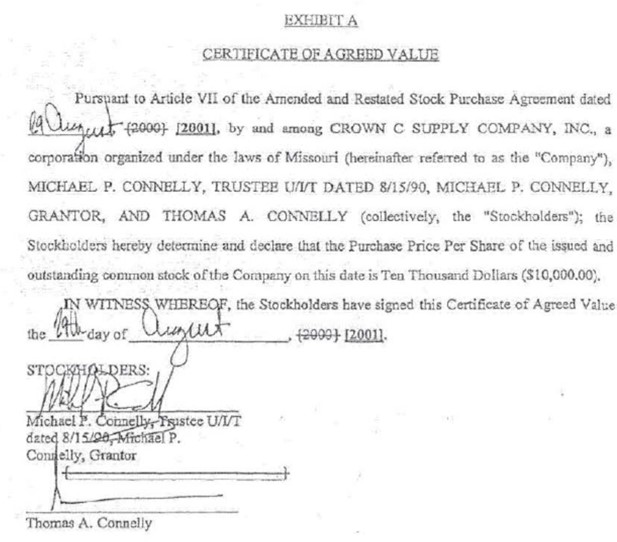
Therefore, at that date, Michael’s shares would have had an agreed value of approximately $3.9 million, while Thomas’s shares would have had an agreed value of approximately $1.1 million. In July 2009, with no update to the agreed value of the company’s equity, Crown C purchased life insurance policies on both Michael’s and Thomas’s lives in the amount of $3.5 million each. The rationale for purchasing the same amount of life insurance on each brother’s life when one brother’s ownership interest was approximately 3.4x larger than the other brother’s is unclear. The SPA dictated that life insurance proceeds were to be used to redeem a deceased shareholder’s interest.
The Sale and Purchase Agreement
Michael, who served as Crown C’s president and CEO, died on October 1, 2013. Thomas was the executor of Michael’s estate. Effective November 13, 2013, Thomas, as trustee of Michael’s trust and a second trust for Molly C. Connelly, Michael’s daughter, recused himself from “all matters touching upon the sale, pricing, negotiation, and transaction of any sale of the stock of Michael P. Connelly, Sr.’s interest in Crown C Supply Company, Inc.”[5] Had Thomas not recused himself he would have been in the conflicted position of negotiating on behalf of Michael’s estate with the company, of which he was now the sole surviving shareholder. Effective the same date, Thomas and Michael’s son, Michael P. Connelly, Jr., executed a sale and purchase agreement governing the redemption of the estate’s shares in Crown C as well as in other entities.[6] Thomas (representing Crown C) and Michael Jr. (representing Michael Sr.’s estate) agreed, without relying upon a formal valuation, to a purchase price of $3.0 million for the estate’s shares (see graphic below).

The estate noted, however, that the $3.0 million purchase price “resulted from extensive analysis of Crown C’s books and the proper valuation of assets and liabilities of the company. Thomas Connelly, as an experienced businessman extremely acquainted with Crown C’s finances, was able to ensure an accurate appraisal of the shares.[7] I’ll discuss the importance of engaging a qualified appraiser in matters such as these below.
The Estate’s Argument: Life Insurance Proceeds Are Not a Corporate Asset
Crown C received $3.5 million in life insurance proceeds upon Michael’s death. Crown C immediately recognized a corporate redemption liability and used $3.0 million of the life insurance proceeds to redeem the estate’s interest in Crown C. It is interesting to note from the graphic above that Michael’s estate’s interest originally was equal to the total cash value of the life insurance proceeds, but at some point was reduced by $500,000 because the company needed additional funding.[8] Exhibit 1 demonstrates this narrative.
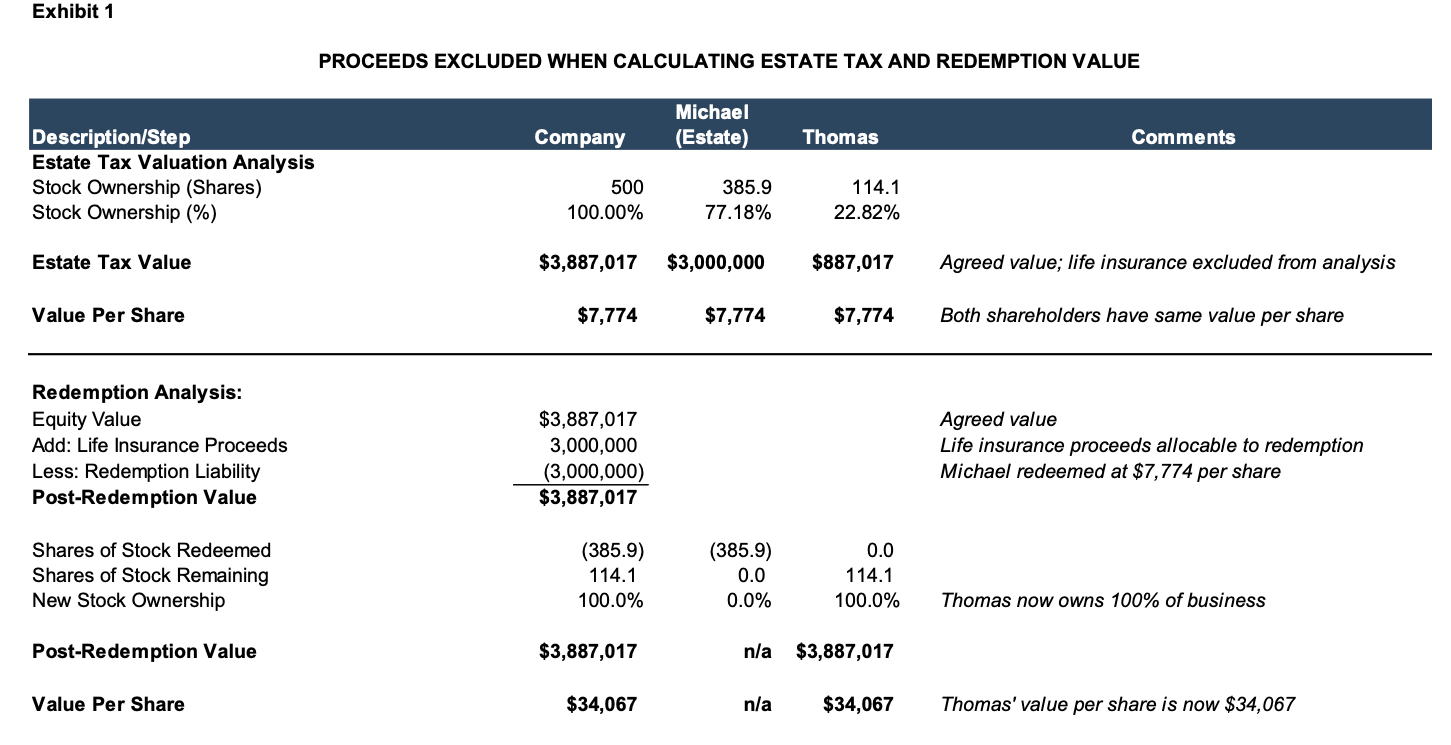
(click here to expand the figure above)
Key takeaways from this scenario:
- One would expect to see a “top-down” valuation methodology in which the value of 100% of Crown C’s equity is established first, followed by the determination of value attributable to the estate’s shares. However, the aggregate value of Crown C’s equity of $3.9 million was implied based on the value of the estate’s interest of $3.0 million.
- Crown C immediately recognizes a redemption liability equal to $3.0 million in life insurance proceeds and pays $3.0 million to Michael’s estate in exchange for redeeming the estate’s 385.9 shares; Michael’s estate is redeemed at $7,774 per share.[9]
- Post-redemption, the total value of the company’s equity does not change while the share count decreases from 500 shares to 114.1 shares, all owned by Thomas.
- Thomas now owns 100% of the company at a value of $34,067 per share,[10] which is approximately 4.4x the value at which Michael’s estate was redeemed. The value of Thomas’s ownership interest increased by 338% with no additional investment.
The IRS’ Argument: Life Insurance Proceeds Are a Corporate Asset
The IRS saw things differently, arguing that the insurance proceeds should be included in Crown C’s equity value. See Exhibit 2 below.
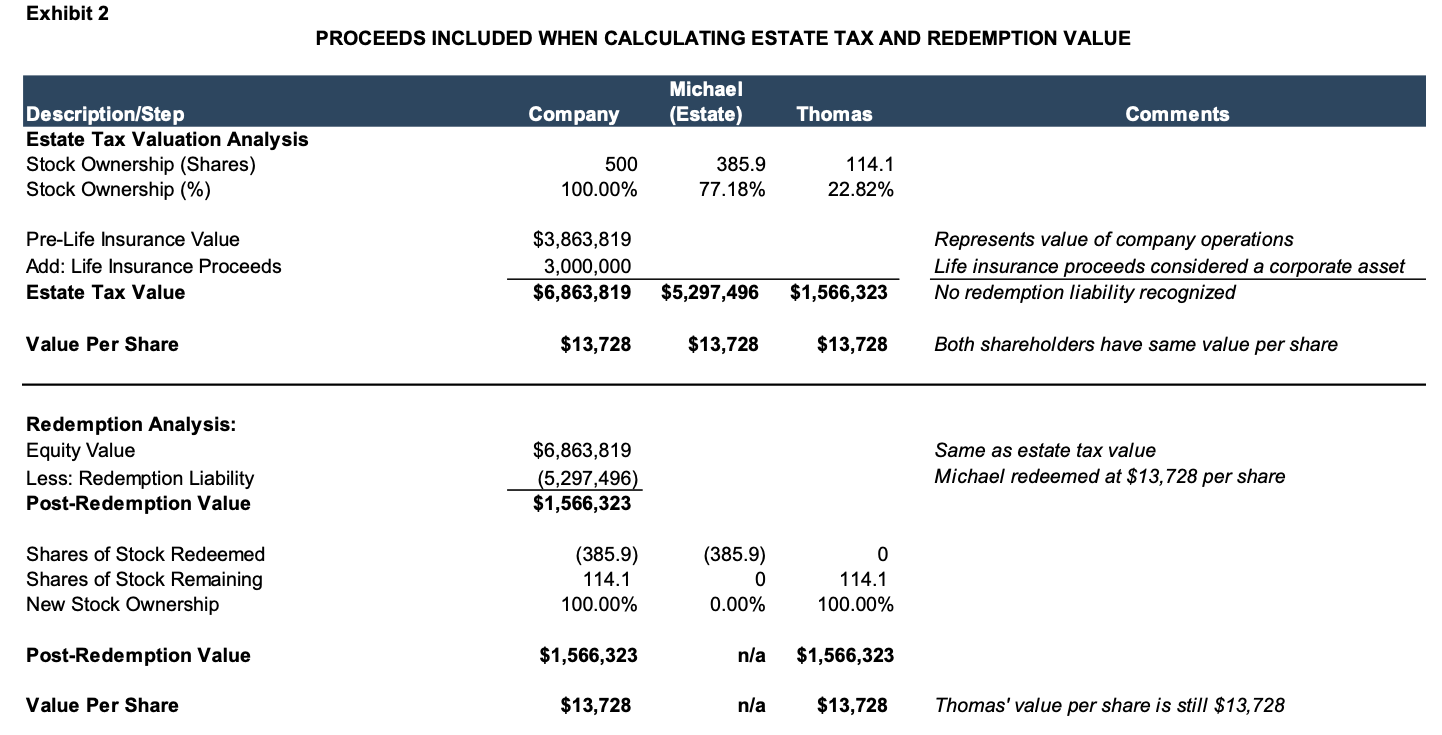
(click here to expand the figure above)
Key takeaways from this scenario:
- The equity value of the business for estate tax purposes was $6.9 million inclusive of the $3.0 million in life insurance proceeds. The IRS did not include the excess $500,000 of life insurance in its valuation.
- The resulting value per share is $13,728[11].
- The estate’s 385.9 shares have a total value of $5.3 million and Michael’s estate is redeemed at $13,728 per share, reducing the company’s equity value to $1,566,323.
- Post-redemption, the share count decreases from 500 shares to 114.1 shares, all owned by Thomas at a value of $13,728 per share, which is equal to the pre-redemption value per share.
- As the life insurance proceeds utilized only totaled $3.0 million, the redemption liability of $5.3 million would have been underfunded by approximately $2.3 million, leaving the company (in this case, solely Thomas) on the hook to finance the shortfall.
The Funding Mechanism Dilemma
It should be obvious that the manner in which life insurance proceeds are treated can have a dramatic impact on the selling shareholder, the remaining shareholders, and the company’s ability to buyout the selling shareholder. In one scenario, the estate is redeemed relative to a windfall received by the surviving shareholder. In the second scenario, the estate is redeemed at a higher value, but to the detriment of the company most likely having to finance a portion of the buyout. So, what is the fair way to treat life insurance in this situation? Ultimately, the parties to the buy-sell agreement decide what is fair with the help of their legal and other professional advisors, but such a decision must be addressed directly and without vagueness in the buy-sell agreement.
The Defining Elements of a Valuation Process Agreement
We now turn to observations of the Connelly SPA itself from a valuation perspective. Valuation process agreements such as the Connelly SPA have six defining elements:[12] (i) standard of value; (ii) level of value; (iii) the “as of” date; (iv) qualifications of the appraiser; (v) appraisal standards; and (vi) funding mechanisms. The first five elements are required to specify an appraisal that is consistent with prevailing business appraisal standards. We’ve seen how the Connelly SPA addressed element #6, funding mechanisms. So, how, then, does the Connelly SPA stack up regarding defining elements #1 through #5?
Standard of Value
Per the American Society of Appraisers ASA Business Valuation Standards, the standard of value is “the identification of the type of value being used in a specific engagement; e.g. fair market value, fair value, investment value.”[13]
Fair market value, the standard that applies to nearly all federal and estate tax valuation matters and which is specified in most buy-sell agreements, is referenced in the Connelly SPA as part of the definition of appraised value per share. Fair market value itself, however, is not defined in the SPA. Without a specific, clear definition of fair market value, such as that from the ASA Business Valuation Standards or the Internal Revenue Code, the interpretation of fair market value is left to the appraiser(s). In the Connelly matter, upon a triggering event two appraisers were to be engaged (one by Crown C and one by the selling shareholder). Should the opinions of these two appraisers diverge by more than 10% of the lower appraised value, a third appraiser could have been engaged. The SPA as drafted opens the door for three interpretations of fair market value. And with multiple interpretations comes the increased likelihood of litigation.
Level of Value
Valuation theory suggests that there are various “levels” of value applicable to a business or business ownership interest. The graphic below depicts these levels. A formal business valuation for gift and estate tax purposes will clearly state the level of value, and therefore, no interpretation is needed as to the applicability of control premiums or discounts for lack of control and lack of marketability.
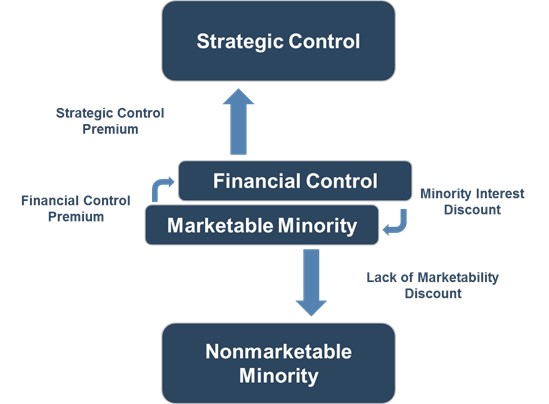
Per the Connelly SPA, in the scenario in which appraisers are utilized in lieu of issuing a certificate of agreed value, “the appraisers shall not take into consideration premiums or minority discounts in determining their respective appraisal values.” In the absence of minority interest discounts, Thomas’s minority interest (22.82%) would have been valued on a pro-rata basis relative to Crown C’s total value.
The As-Of Date
Every appraisal has an “as-of” date, more commonly referred to as the valuation date. Why is the valuation date important? Business appraisers rely upon information that was “known or reasonably knowable” on the valuation date. For purposes of filing Form 706, the valuation date is the date of death (estates may elect the alternate date, six months from the date of death, as the valuation date). For redemption purposes, however, the Connelly SPA refers to “Appraisal Date,” which is “the date an option is exercised or a mandatory purchase is required.” As such, the Connelly SPA does allow for a redemption to occur on a specific date.
Qualifications of Appraisers
If the qualifications of an appraiser are not specified, just about anyone can do the appraisal. The Connelly SPA mentions that an appraiser “shall have at least five years of experience in appraising businesses similar to the Company.” That’s it. The SPA makes no mention of formal education, valuation credentials such as ASA, ABV, or CVA, or continuing education and training requirements.
Ultimately, this was a moot point for Connelly because no appraiser was ever hired to do a valuation. But what could happen if an unqualified appraiser is hired to perform a valuation? A recent tax court case, Estate of Scott M. Hoensheid, deceased, Anne M. Hoensheid, Personal Representative, and Anne M. Hoensheid, Petitioners, v. Commissioner of Internal Revenue Service, Respondent (T.C. Memo 2023-34), addressed this situation head-on. While the case was related to the donation of closely held stock, not using a qualified appraiser had a damaging impact on the taxpayer. The company whose shares were subject to the charitable gift had been marketed for sale by an investment banker prior to the gift. The taxpayer’s attorney suggested that the investment banker be considered to do the appraisal for the gifting because “since they have the numbers, it would seem to be the most efficient method.”[14] In court, the petitioners argued that the investment banker was qualified because he had prepared “dozens of business valuations” over the course of his 20+ year career as an investment banker.
According to the court, an individual’s “mere familiarity with the type of property being valued does not by itself make him qualified.” The court further noted that the investment banker “does not have appraisal certifications and does not hold himself out as an appraiser.” The court relied on testimony at trial about appraisal experience to be instructive, as the investment banker testified that he conducted valuations “briefly” and only “on a limited basis” before starting at the investment bank the year before the appraisal. The investment banker also testified that he performed (presumably at no charge) business valuations for prospective clients “once or twice a year” in order to solicit their business. The court found the investment banker’s “uncontroverted testimony sufficient to establish that he does not regularly perform appraisals for which [he] receives compensation.”
The end result for the taxpayer in Hoensheid: the Tax Court found that the taxpayer failed to comply with the qualified appraisal requirements and denied the charitable deduction.
Appraisal Standards
Occasionally, buy-sell agreements lay out the specific business appraisal standards to be followed by the appraiser. Standards most often cited in buy-sell agreements are the Uniform Standards of Professional Appraisal Practice (commonly referred to as “USPAP”), the ASA Business Valuation Standards, AICPA’s Statement on Standards for Valuation Services No. 1 (commonly referred to “SSVS”) and NACVA’s Professional Standards. The Connelly SPA did not reference any of these standards. Without any appraisal standards referenced, any appraiser elected to perform a valuation under the SPA who was not a member of one of the national appraisal organizations has no requirement to follow any set of standards or code of ethics.
Tax Court Conclusions
Connelly was first decided by the District Court in September 2021. Having been appealed by the estate, the Eighth Circuit affirmed the District Court’s decision in June 2023.
The District Court Decision
The IRS had contended that the life insurance proceeds should be included in the valuation of Crown C’s equity. The estate argued that the redemption obligation was a corporate liability that offset the life insurance proceeds dollar for dollar. The District Court sided with the IRS, noting that “Because the insurance proceeds are not offset by Crown C’s obligation to redeem Michael’s shares, the fair market value of Crown C at the date of date of death and of Michael’s shares includes all of the insurance proceeds.”[15]
The Circuit Court Decision
The Circuit Court affirmed the District Court’s decision, noting “In sum, the brothers’ arrangement had nothing to do with corporate liabilities. The proceeds were simply an asset that increased shareholders’ equity. A fair market value of Michael’s shares must account for that reality.”[16]
Current Status
Shareholder buyouts often occur at inconvenient times, and poor planning can have financially devastating consequences. In Connelly, a poorly drafted buy-sell agreement resulted in a notice of deficiency from the IRS in the amount of $998,155 [17] and undisclosed legal and professional fees incurred to litigate the matter. The estate has sought a refund of $1,027,042 that it views was “erroneously, illegally, and excessively assessed against and/or collected from Plaintiff as federal estate tax…”[18] In August 2023, counsel for the estate filed with the Supreme Court of the United States a petition for a writ of certiorari to the United States Court of Appeals for the Eight Circuit. On December 13, 2023, the Supreme Court granted the petition for writ of certiorari, signifying its acceptance of the case for review. As of February 2024, the case had not yet been set for argument.
[1] Courts have had differing opinions on the life insurance/valuation matter. In Estate of George C. Blount, Deceased, Fred B. Aftergut, Executor, v. Commissioner, the United States Court of Appeals, Eleventh Circuit ruled that life insurance proceeds used to redeem a stockholder’s shares do not count towards the fair market value of the company when valuing those same shares.
[2] The buy-sell agreement that is the subject of Connelly was challenged by the IRS as invalid for controlling the valuation of the subject company’s stock in an estate tax scenario. The district and circuit courts both agreed and deemed the buy-sell agreement invalid.
[3] Crown C was sold to SRS Distribution, Inc., a portfolio company of Leonard Green & Partners and Berkshire Partners, in 2018. Terms of the deal were not disclosed. Crown C continued to serve the St. Louis market as of the publication date of this article.
[4] Amended and restated stock purchase agreement by and among Michael P. Connelly, trustee U/I/T dated 8/15/90, Michael P. Connelly, grantor, and Thomas A. Connelly, executed effective August 29, 2001.
[5] Sale and purchase agreement by and among Thomas A. Connelly, trustee of The Michael Connelly Irrevocable Trust dated 15 August 1990, Crown C Supply Co., Inc., a Missouri Corporation, Thomas A. Connelly, individually, Connelly Partnership/Connelly, LLC, and 5200 Manchester, LLC, executed November 13, 2013.
[6] Ibid.
[7] Connelly v. United States, Memorandum and Order, page 21, September 2021.
[8] Appeal from the United States District Court for the Eastern District of Missouri – St. Louis, No. 21-3683, page 3, filed June 2, 2023.
[9] ($3.0 million / 385.9 shares) = $7,774 / share.
[10] ($3.9 million / 114.1 shares) = $34,067 per share.
[11] ($6.9 million / 500 shares)
[12] Mercer, Z. Christopher, Buy-Sell Agreements for Closely Held and Family Business Owners (Peabody Publishing LP, 2010).
[13] American Society of Appraisers Business Valuation Standards (approved through November 2009).
[14] T.C. Memo. 2023-34; Estate of Scott M. Hoensheid, deceased, Anne M. Hoensheid, Personal Representative, and Anne M. Hoensheid, Petitioners, v. Commissioner of Internal Revenue Service, Respondent.
[15] Connelly v. United States, Memorandum and Order, page 35, September 2021.
[16] Appeal from the United States District Court for the Eastern District of Missouri – St. Louis, No. 21-3683, page 13, filed June 2, 2023
[17] Complaint of Thomas A. Connelly, Executor of the Estate of Michael P. Connelly, Sr. dated May 23, 2019.
[18] Ibid.
The Tangled Path to Banking’s Garden of Earthly Delights

Hieronymus Bosch, The Garden of Earthly Delights, 1490-1510, Museo del Prado, Madrid.
One of BankWatch’s favorite artists is the Dutch painter Hieronymus Bosch (1450-1516). His work is both enigmatic and fantastical, with bizarre human/animal hybrid forms and other monstrous creations of Bosch’s fecund imagination. Indicating its lasting relevance and, in a sense, modernity, centuries later Bosch’s work served as inspiration when the Surrealist movement sought to depict dreamlike scenes formed from the depths of their unconscious mind. One triptych, The Garden of Earthly Delights, depicts a utopian scene in the middle panel adjacent to a hellscape in the right panel. It serves as an apt metaphor for the banking industry’s stomach churning volatility in 2023.
As in the hellscape panel on the right side of the triptych, the banking industry sunk to the depths of despair beginning in March 2023, tormented by bank failures and deposit runs. From year-end 2022 to the nadir in May 2023, the Nasdaq Bank Index sunk 34%. Bank stocks rebounded during the summer but remained under pressure through the fall as the ten year Treasury rate briefly exceeded 5%.
Finally, more dovish comments from Chairman Powell lifted sentiments, causing the Nasdaq Bank index to appreciate by 12% in November 2023 and 15% in December 2023. While we have not returned to a banking utopia, the greener pastures in which Bosch’s hybrid forms graze in the triptych’s middle panel seem more representative of industry conditions at year-end 2023.
2023 Performance
For 2023, the Nasdaq Bank Index and the KBW Nasdaq Regional Bank Index depreciated by 7% and 4%, respectively (see Figure 1 ). This marks the second year of negative performance for bank stock indices. Between year-end 2021 and 2023—covering the entire period of rising rates—the Nasdaq Bank and Regional Bank indices decreased by 24% and 13%, respectively (see Figure 2).
After losing 19% in 2022, the S&P recovered in 2023 with 24% appreciation, meaning that the S&P 500 at year-end 2023 returned to a level virtually identical to year-end 2021. Struggling with earnings pressure, banks lost favor with growth minded investors, thereby underperforming the broader market.
Figure 1 :: Index Performance (12/31/22 – 12/31/23)

Figure 2 :: Index Performance (12/31/21 – 12/31/23)
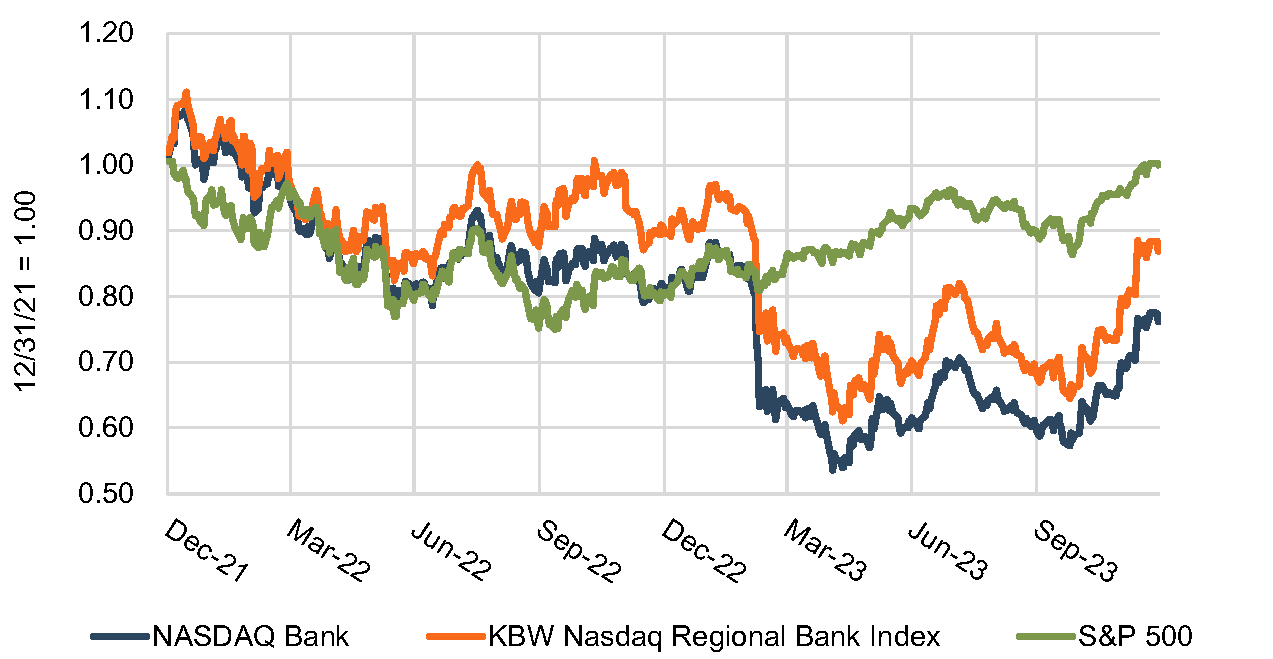
Figure 3 stratifies the 328 banks and thrifts traded on the NYSE and Nasdaq by asset size. Banks in the three strata between $1 billion and $100 billion performed similarly, with the median bank’s stock price falling by about 5% in 2023. Between 30% to 40% of banks reported share price appreciation over year-end 2022. The largest banks outperformed in 2023, as several banks like J.P. Morgan Chase (NYSE: JPM) “over-earned” their long-term return on equity target. JPM and other money center banks were boosted by low-cost deposits flowing from smaller banks in the wake of the failures of SVB, Signature Bank, and First Republic Bank. JPM also recorded a bargain purchase gain from the acquisition of First Republic Bank as did First Citizens BancShares (NYSE: FCNCA) and New York Community (NYSE: NYCB), the winning bidders for SVB and Signature Bank.
Figure 3
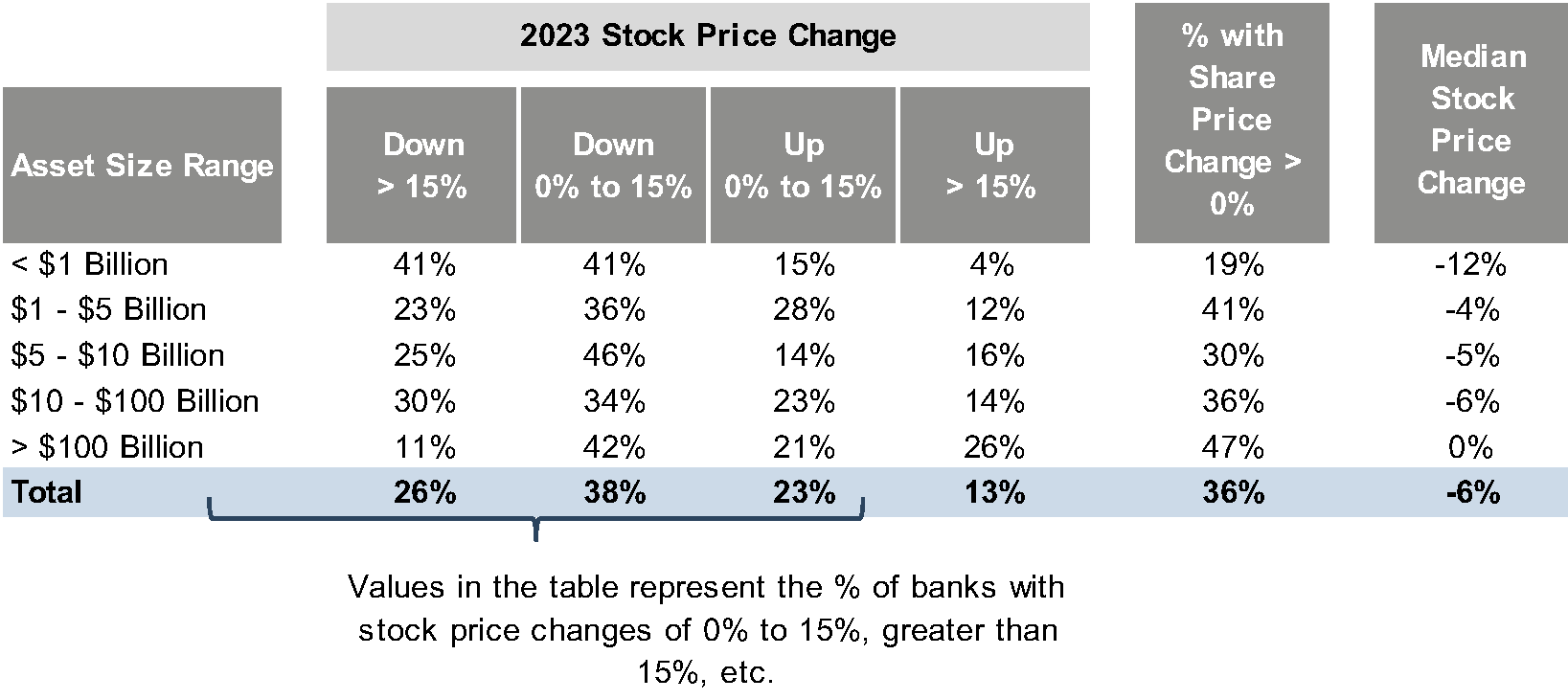
Figure 4 replicates the analysis for the period between year-end 2021 and year-end 2023. Not all banks have struggled through this rising rate environment, as 28% of banks reported share price appreciation over the two year period. Nevertheless, the largest number of banks have experienced a 10% to 20% decline in their share prices.
Figure 4
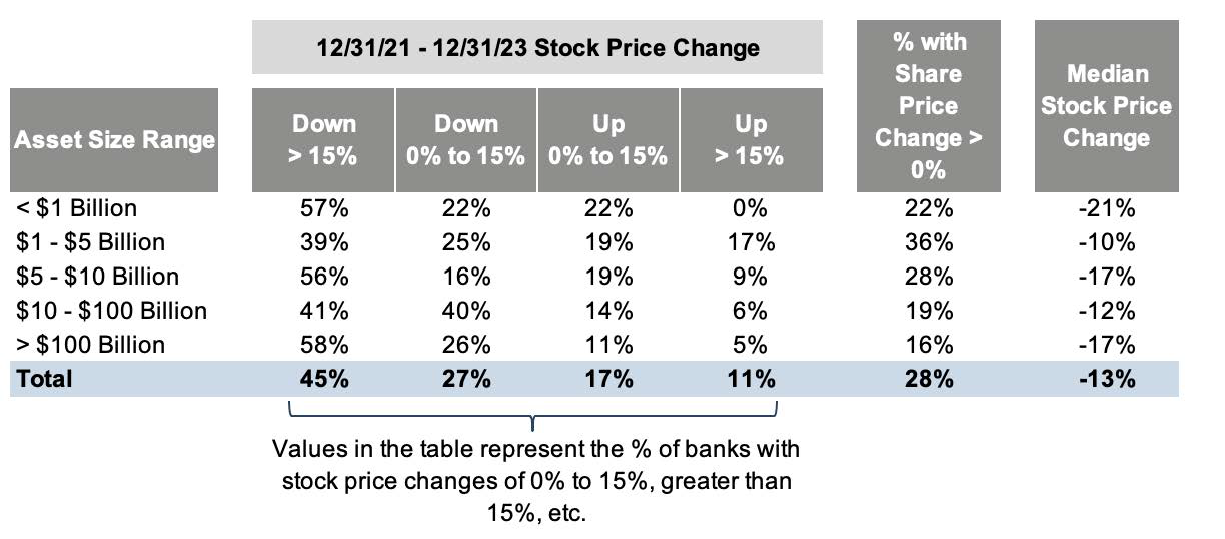
Catalysts for (Under)Performance
Changes in the net interest margin have the greatest effect on profitability and share price performance in the current environment, given limited credit issues. Figure 5 includes publicly traded banks with assets between $1 billion and $10 billion, sorted into quartiles based on their NIM change between the fourth quarter of 2022 and the third quarter of 2023.
Figure 5
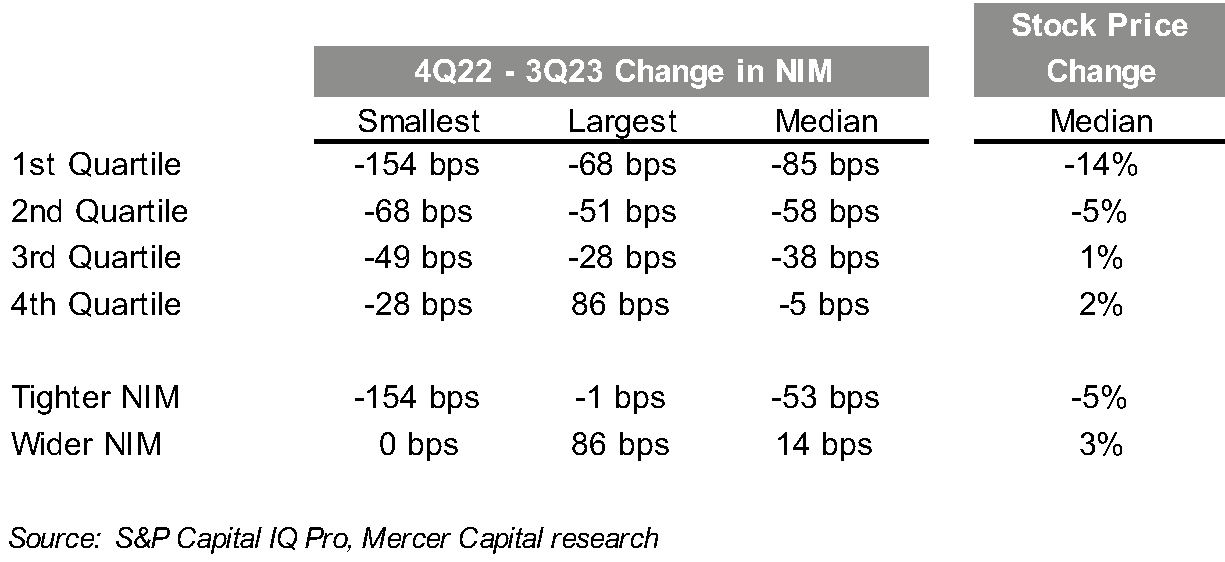
The first quartile, including banks with the most severe NIM pressure, experienced a median stock price change of negative 14% in 2023. Meanwhile, banks in the fourth quartile—with the least NIM pressure or even NIM expansion—eked out a positive 2% change in stock price.
This relationship holds true if we consider the entire rising rate period between the first quarter of 2022 and the third quarter of 2023 (see Figure 6). Over this period, approximately one-half of the banks reported a higher NIM; however, the market provided a meager reward with share prices for banks in the fourth quartile appreciating by a median of 4%. This reflects the market’s focus on the more recent trend in the margin—generally downward for most banks—rather than a historical anchor in a low rate environment. Meanwhile, the banks in the first quartile that were most exposed to rising rates suffered a median -24% change in their stock prices.
Figure 6
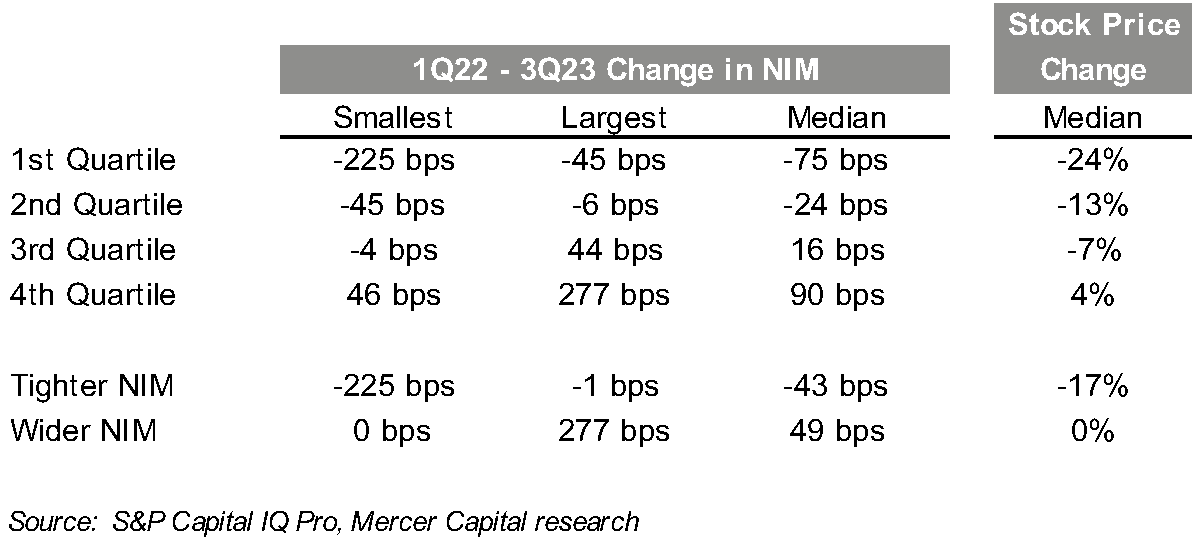
Valuation Implications
Figure 7 illustrates the earnings pressure resulting from tighter NIMs. For 2023, analysts’ EPS estimates indicate a median EPS decline of 15% for publicly traded banks with assets between $1 and $15 billion, with 73% of the banks in the analysis expected to face lower year-over-year earnings in 2023. These estimates are based upon recent data. Measured from January 2023, the reduction in earnings estimates is much more severe, meaning analysts cut estimates as the year progressed.
Figure 7
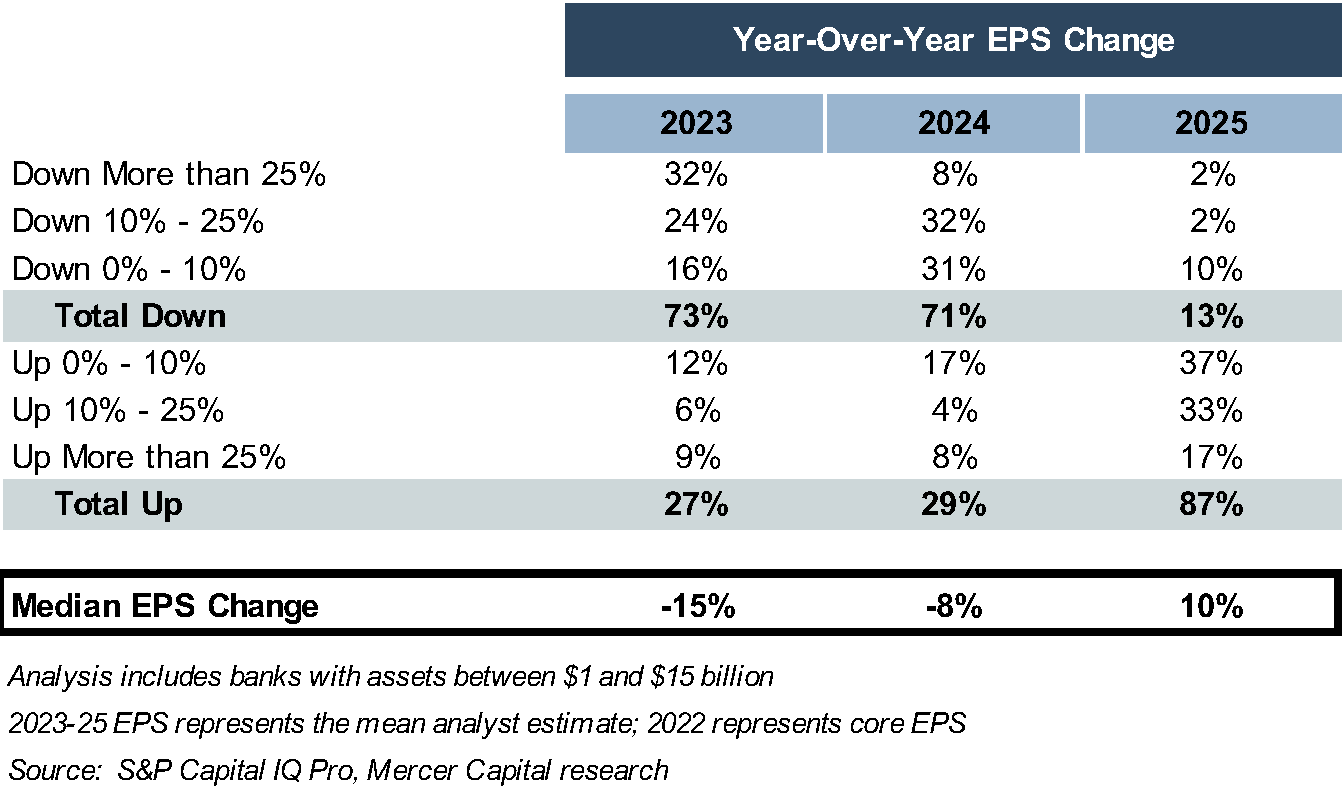
The outlook is only marginally better in 2024, as the median decline in EPS is 8%. Analysts generally expect NIMs to stabilize, or at least decline at a more modest rate, in the first half of 2024, followed by some expansion in the second half of 2024. The NIM stabilization in the latter half of 2024 leads to earnings growth in 2025 for most banks, with a median EPS growth rate of 10%. However, only 28% of banks in our analysis are projected to have higher EPS in 2025 than in 2022.
With the share price recovery in late 2023, publicly traded banks with assets between $1 and $15 billion reported a median price/one year forward earnings multiple of 11.5x and a price/tangible book value multiple of 1.26x. As indicated in Figure 8, these multiples are in-line with the range over the last five years. Therefore, the catalyst for further share price appreciation likely will be earnings improvement rather than P/E multiple expansion.
Figure 8
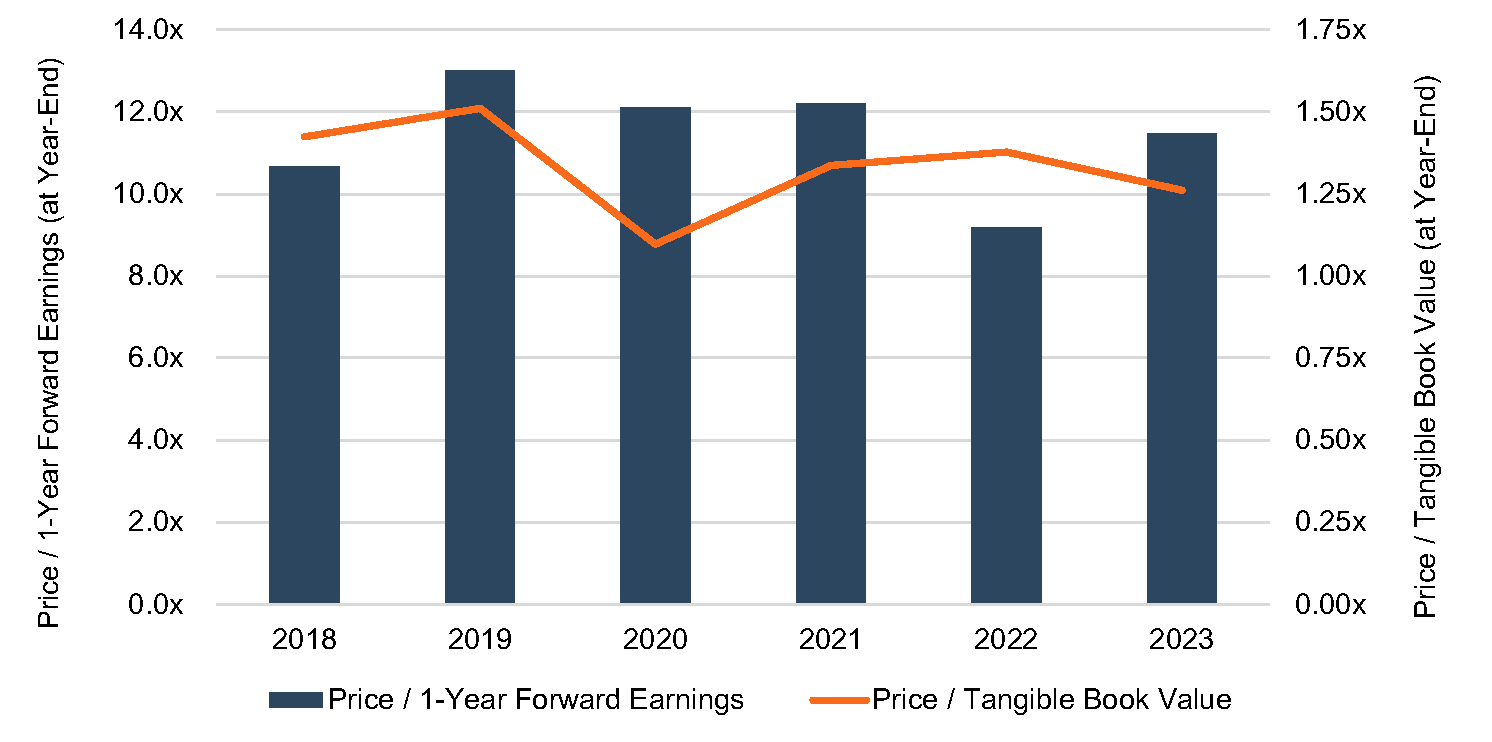
Conclusion
The worst has passed for banks, with slowing deposit attrition and stabilizing NIMs, unless credit performs materially worse than expected. However, conditions likely are not ripe for rapid earnings growth. First, NIMs likely will recover more slowly than they contracted due to volume of assets repricing years into the future. Second, many banks are reporting slowing loan growth, as higher rates have gradually eroded loan demand. Third, if loan demand exists, marginal funding remains difficult to obtain at a favorable cost of funds. For many publicly traded banks, returning to the garden of earthly delights remains a ways off.
Goodwill Impairments Are on the Rise. Surprised?
Executive Summary
Preliminary results for 2023 show that the number of goodwill impairments is increasing for both large and middle-market public companies. Based on data through November, the number of impairments recorded by firms on the S&P 500 and Russell 2000 indices had already eclipsed 2021 and 2022 full-year figures. Interestingly, these trends materialized even as the indices themselves posted favorable total returns for the year of 25% and 14%, respectively. Public and private companies currently in the process of performing their annual/interim impairment tests should be on the alert if their peer group turns out to be the one recording impairment charges.
Back in 2020, the stock market downturn stemming from pandemic shutdowns resulted in triggering events and impairment charges for many companies. This was especially evident among smaller publicly-traded companies (as tracked by the Russell 2000 versus the S&P 500). The number of charges dropped drastically in 2021 (even compared to 2019 results), suggesting that some of the 2020 impairment charges may have reflected a pull-forward of later charges. Since that time, the number and percentage of companies recording charges has steadily increased, with preliminary figures for 2023 already exceeding the numbers recorded in 2022.
Total Goodwill Impairment Charges and % of companies with GW that recorded charges
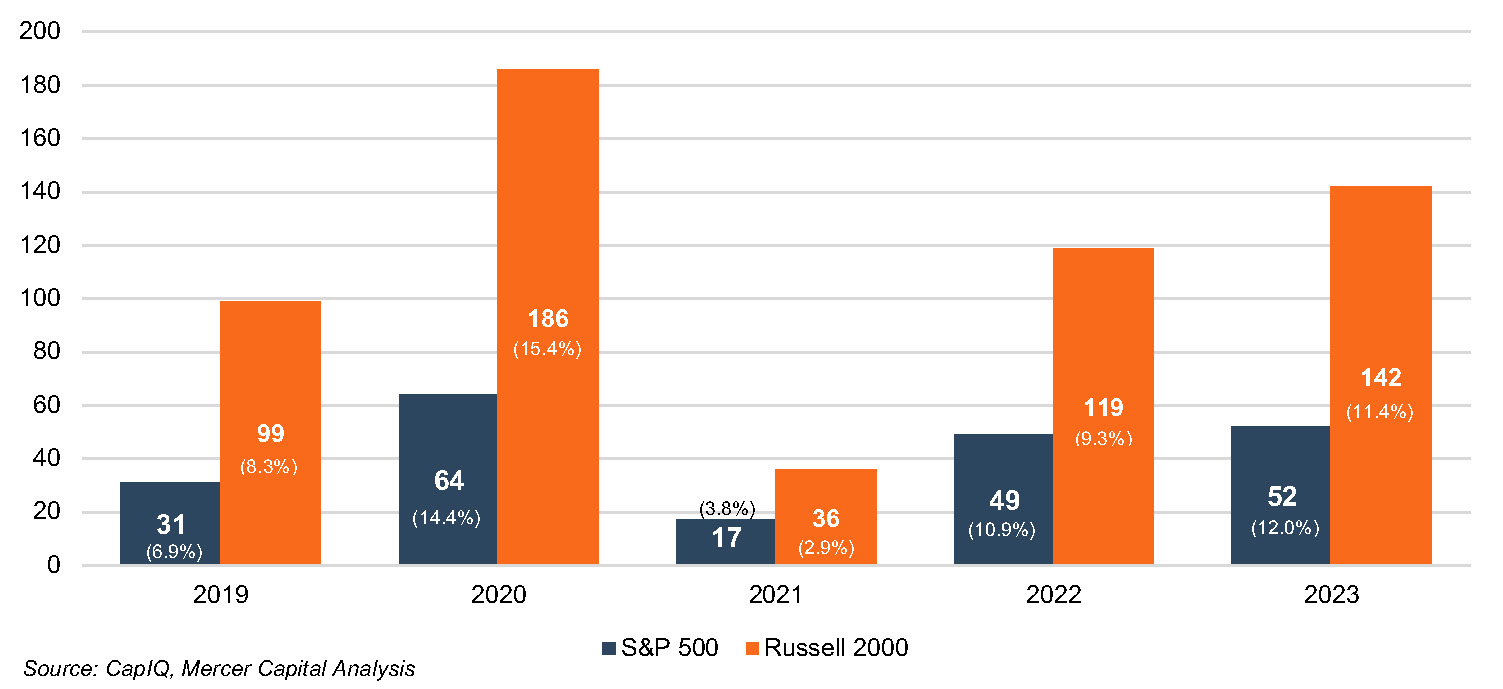
This trend held across sectors as well. In the Russell 2000, eight of eleven sectors reported an increase in number of charges to goodwill between 2019 and 2020. Charges in the consumer staples sector declined among S&P 500 companies, while increasing for Russell 2000 companies. Charges in the utilities sector declined for S&P 500 companies but remained stable for Russell 2000 companies. For both groups of companies, charges taken by the materials sector declined. Following 2020, impairment charges dropped below 2019 levels – sharply, in the case of many sectors over 2021 through 2022.
More recently, the number of charges and the magnitude of total goodwill charges for the first eleven months of 2023 had already exceeded the full year of 2022. Additional impairments may be on the way as companies complete and file their year-end financials. Based on the preliminary figures for the Russell 2000, the sectors recording the most charges appear to be healthcare and industrials.
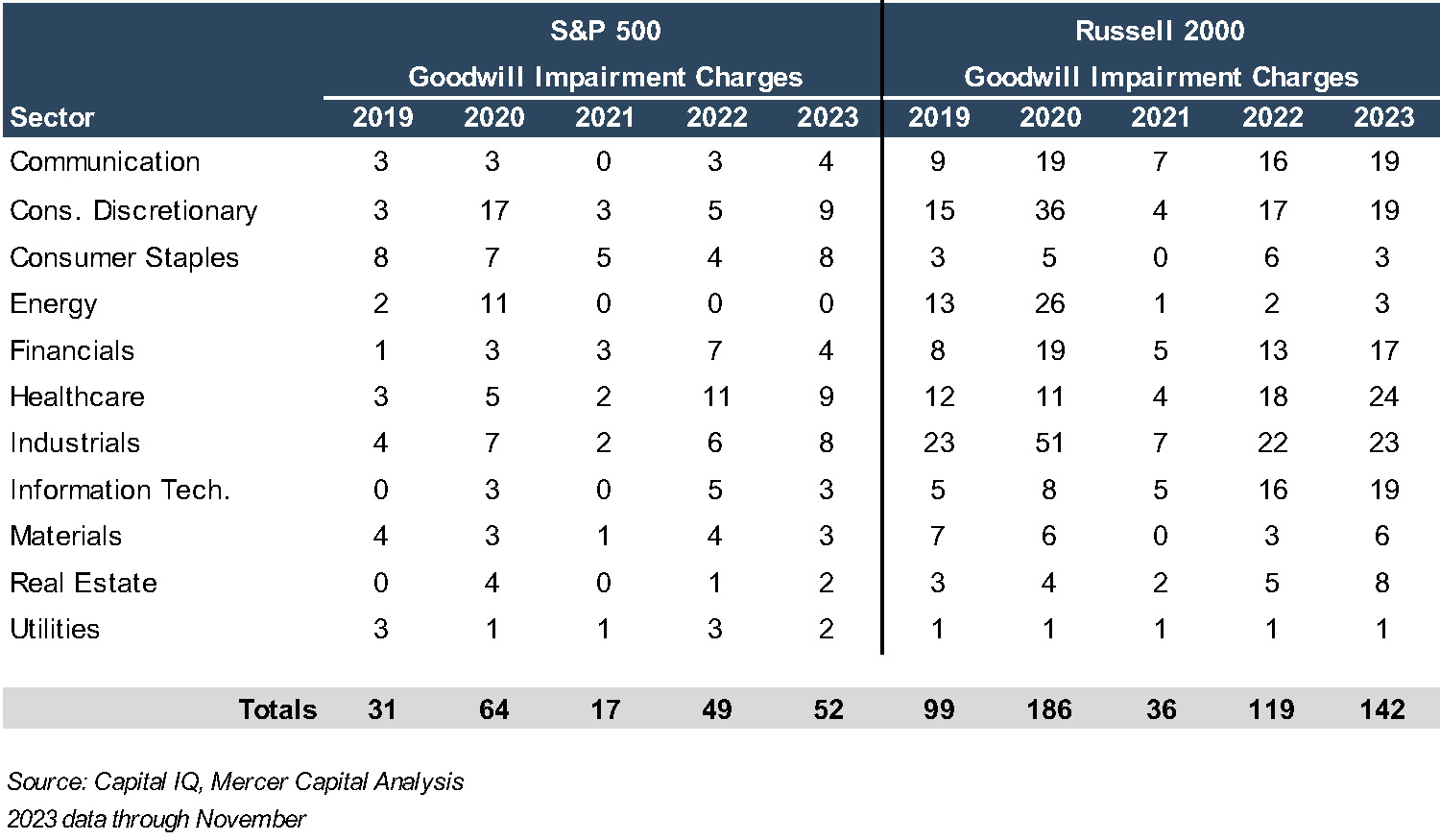
Despite the increase in impairment charges taken in 2020, the number of small-cap companies reporting year-end goodwill balances increased in 2020 and continued to increase through 2022 and 2023. Approximately 60% of Russell 2000 companies carried goodwill in 2019, while over 63% did so in 2023. The percentage of S&P 500 companies reporting goodwill declined from 89% in 2019 to 86% in 2023.
Percent of Companies Reporting Goodwill
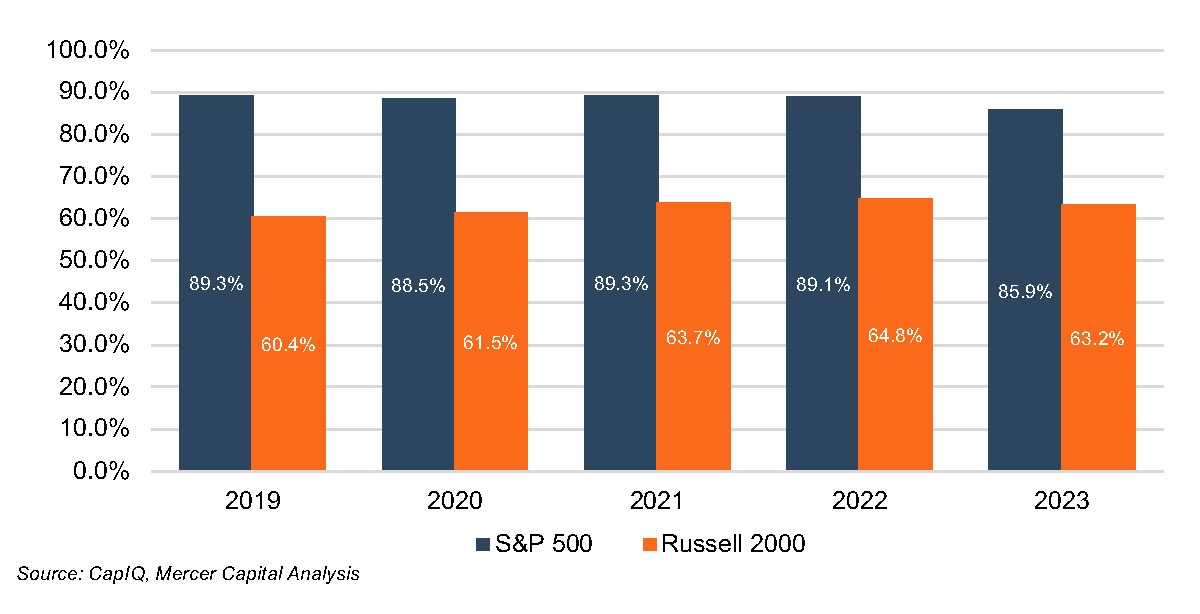
It is impossible to attribute the rise in impairment charges to a single specific factor. However, it is likely that rising interest rates and higher inflation played a significant role in 2023 results. Impairment charges also tend to have a larger impact on smaller companies. Generally speaking, smaller companies tend to be less diversified in terms of product or service offerings, and their client bases may be more sensitive to external economic factors.
Ultimately, the preliminary data for 2023 shows that impairments do not necessarily taper off when overall equity markets are rising. Company-specific factors, including financial performance relative to history, expectations, and peer performance, are critical when evaluating goodwill for potential impairment. Will the impairment trends seen in the large and middle-market public markets extend to private companies? Perhaps.
The valuation specialists at Mercer Capital have experience in implementing both the qualitative and quantitative aspects of goodwill impairment testing under ASC 350. If you have questions, please contact a member of Mercer Capital’s Financial Statement Reporting Group.
Evaluating Your Firm’s Margin
We start the new year with an industry-focused piece, sharing a recent article from our Investment Management blog, RIA Valuation Insights. The industry focus is intentional because we have provided family law valuation and forensic services to numerous owners (and spouses of owners) of RIAs/wealth management firms. In addition, the broader topic of understanding the role of a firm’s margin in valuation is important for family law attorneys as well as other parties to a divorce.
An RIA’s margin is a simple, easily observable figure that condenses a range of underlying considerations about a firm that are more difficult to measure. As much as a single metric can, margins reflect the health of a firm—indicating whether a firm has the right people in the right roles, whether it’s charging enough for services, whether it has enough (but not too much) overhead, and much more. But when assessing your firm’s margins, it’s important to consider the context of the firm’s ownership and compensation structure and also the tradeoffs associated with margins that are too high or too low.
Consider the typical cost structure in the industry: For most RIAs, costs other than compensation (things like rent, data services, professional services, tech vendors, insurance, etc.) might total 20% or less of revenue. The remaining 80% (or more) remains with the firm’s stakeholders, either going to employees in the form of compensation or shareholders in the form of distributions. The line between compensation and distributions can often blur because of the overlap between employees and shareholders. To add to the confusion, the primary input to investment management is talent—something that’s hard to quantify and certainly isn’t a commodity; benchmarking services can provide perspective, but no compensation database can tell you precisely how much a particular individual “should” make.
Margins can be a convenient shorthand for the firm’s operational success, but the nature of the industry’s cost structure lends to significant discretion in how to split pre-compensation profits between returns to labor (in the form of compensation) and returns to capital (in the form of distributions). With that discretion comes tradeoffs. Striking the right balance between margin and compensation is an important aspect of building a sustainable and growing enterprise.
If margins are too low, the economic benefits from the firm’s operations flow primarily to employees, not shareholders. The result is that there’s little incentive for ownership, which can make internal transactions difficult from a cash flow and valuation perspective. On the other hand, if margins are too high, employee retention may suffer, and it may be difficult to replace employees in the event of turnover. Spending less on employees is also a tradeoff with growth. Firms that limit investment in employees may be trading margin now for growth opportunities later. All of these considerations can be exacerbated if outside shareholders are present or if ownership by employee shareholders is disproportionate to their contribution to the firm.
Margins and Valuation
From a valuation perspective, high margins are desirable, but buyers are particularly mindful of the durability of those margins and the firm’s future growth prospects. A high-margin firm isn’t necessarily a firm that commands a high multiple—and in fact, the reverse may be true if buyers expect the firm’s margins to contract. Similarly, a low-margin firm growing rapidly and with a cost structure in place such that margins can be reasonably expected to expand over time may command a higher multiple of current profitability.
Another factor to consider is how a firm’s current margin is achieved in the first place. If a firm runs with an above-peer margin, is it because they’ve grown rapidly but efficiently, taking advantage of operating leverage and scale, or have they slashed necessary overhead costs and skimped on compensation? The former might be worth a premium; the latter might be viewed as unsustainable, or the lack of employee incentives might be viewed as compromising future growth opportunities. Margin that comes from revenue growth and scale rather than cost cutting is likely to be viewed more favorably from a valuation perspective.
How does all of this relate back to compensation decisions? In our experience, the most successful (and valuable) firms tend to have a few things in common that help them navigate the “margin vs compensation” dilemma. One commonality is broad-based employee ownership, which mitigates many issues that can otherwise arise in determining returns to capital versus returns to labor. Another commonality is that such firms typically have significant variable compensation programs that align incentives between employees and shareholders and serve as a “shock absorber” that keeps the firm’s margin within a reasonable, sustainable range in both upside and downside scenarios.
The presence of such incentive compensation mechanisms can dramatically impact growth: According to Schwab’s 2022 RIA Compensation Report, firms using performance-based incentive pay saw growth in net asset flows 34% greater than firms that did not use such incentives over a five-year period. While these firms likely sacrificed some margin in the form of higher incentive compensation to achieve this growth, sustained organic growth is a far better builder of long-term shareholder value than sustained margin without growth.
Conclusion
In the investment management world, evaluating a firm’s margin isn’t as simple as “more is better.” For RIAs, margin reflects efficiency, but it also reflects the firm’s tradeoffs with compensation. Investment management is a talent business, and striking the right balance between margin and employee compensation that allows the firm to attract, retain, and incentivize talent is critical to an RIA’s success.
About Mercer Capital
We are a valuation firm that is organized according to industry specialization. Our Investment Management Team provides valuation, transaction, litigation, and consulting services to a client base consisting of asset managers, wealth managers, independent trust companies, broker-dealers, PE firms and alternative managers, and related investment consultancies.
Forward Air Corporation to Acquire Omni Logistics, LLC?
Another tough call for the merger arb community – acquirer and target sue each other in Delaware Court of Chancery to respectively terminate the merger agreement or force consummation of the merger
In past issues of the Transaction News Advisor, we have noted that deals sometimes can be tough to close. Often this involves a regulatory obstacle as has occurred in the JetBlue-Spirit saga and the TD-First Horizon deal that was terminated in May 2023. Occasionally circumstances will change – another suitor emerges willing to pay the break-up fee; the target’s financial performance materially deteriorates; or the buyer has an inability to meet its obligations. And sometimes human emotion becomes a factor when the buyer or seller has remorse as seen with Twitter when Elon Musk sought to terminate the deal but was forced to close in October 2022 when it became apparent his legal bid to walk away would fail in the Delaware Court of Chancery.
The pending acquisition of Omni Logistics, LLC by Forward Air Corporation (NASDAQGS: FWRD) is another recent deal that has iffy prospects of closing. FWRD management and the board apparently did not appreciate the visceral reaction the terms of the deal would trigger among some of its institutional shareholders, which is surprising given its advisors included Morgan Stanley, Citigroup and Cravath, Saine & Moore.
On August 10, 2023, FWRD announced that it would acquire the heavily indebted Omni for an enterprise valuation of $3.2 billion. Consideration to be paid to Omni’s shareholders includes $150 million in cash, 5.1 million common shares and 10.6 million convertible preferred shares that was valued at ~$1.8 billion based upon FWRD’s August 9 closing price of $110 per share. The enterprise valuation at announcement equated to 18x LTM adjusted EBITDA and about 11x with projected synergies.
Omni shareholders would own 38% of FWRD upon conversion of the preferred shares provided that FWRD shareholders approve the deal after it closes; otherwise, the preferred shares will be entitled to a ~13% dividend. Under Tennessee law and most state business corporation acts, shareholders of the acquirer vote to approve a transaction when the consideration entails common shares that exceed 20% of the outstanding shares. In the case of the FWRD-Omni deal, the 5.1 million common shares to be issued at closing represent 19.9% of FWRD’s existing 25.7 million common shares; hence, FWRD shareholders will not have the opportunity to vote the deal down before it closes.
Investors punished FWRD shares, which fell from $110 per share on August 9 to the low $60s within a week as certain institutional shareholders urged the board to reconsider. Since then, the shares have drifted lower to $53 per share as of January 16, 2024, as shown on the charts below.
During late September, three shareholders including the x-CFO filed suit in Tennessee’s Third District Chancery Court seeking to block the transaction, which prompted the court to issue a temporary restraining order (TRO). On October 17, shareholder Ancora Alternatives announced its opposition to the deal and called for a special shareholder meeting to elect new FWRD directors who would terminate the deal and pursue a different plan to create value.
On October 25, the TRO blocking the deal was lifted; however, on October 26, FWRD notified Omni that it had failed to satisfy certain obligations specified in the agreement and therefore FWRD would exercise its right to terminate the agreement. Among the issues that FWRD has raised is Omni’s 2023 EBITDA forecast that apparently has deteriorated since the deal was negotiated.
On October 31, Omni filed suit in the Delaware Court of Chancery to force FWRD to close, while FWRD counter sued on November 13 that it is not obligated to close. The Court hearing, scheduled to begin January 19, was delayed at least several days due to weather.


Bank M&A 2023
Subdued But Potentially Explosive
M&A activity was depressed for a second consecutive year in 2023 as M&A pricing fell to multi-decade lows excluding the Great Financial Crisis (GFC) years. At some point, we expect an explosive rebound though a recession—especially a deep one—would delay the liftoff. In the interim, recap transactions may increase as seen with the recently announced $150 million recapitalization of Blue Ridge Bancshares Inc. (NYSEAM: BRBS).
As of December 21, only 96 bank and thrift deals had been announced, which equated to about 2.0% of the number of charters as of January 1 – a level that is equivalent to the recession years of 1991 and 2009. The aggregate deal value for transactions that included disclosed pricing was only $4.6 billion, by far the lowest deal value since 1990 when an equivalent amount of non-assisted deals was announced. Adjusted for inflation, deal value was ~40% of 1990.

Source: S&P Global Market Intelligence
Click here to expand the image above
Emblematic of the tough M&A environment was the terminated merger agreement between Toronto-Dominion Bank (NYSE: TD) and First Horizon (NYSE: FHN) in May 2023. The failed deal represented another negative datapoint for bank investors following the failures of Silicon Valley Bank and Signature Bank in March and First Republic Bank on May 1. All three banks were members of the S&P 500, and the CEO of SVB was a director of the Federal Reserve Bank of San Francisco.
TD was unable to secure regulatory approval for the merger that was announced in February 2022 that would have entailed $13.5 billion of cash consideration, or $25.00 per share for First Horizon. Pricing equated to 227% of year-end 2021 TBVPS and ~17x the 2022 EPS consensus estimate.
At announcement, the Fed was expected to gradually lift rates in 2022 to the benefit of bank earnings. When the deal was called off, FHN’s shares fell to ~$11 per share because there would be no cover bidder to step forward and because banks had been revalued to 7-9x earnings as rapidly rising rates created a myriad of problems, including declining NIMs and EPS estimates. Additional perspective on the deal can be found here.
Roller Coaster Markets
The bear markets that developed for bank stocks and fixed income in 2022 continued until 2023 when a November rally in the bond market, confirmed by a Fed pivot on December 13, lessened the pain. Among the data points:
- The NASDAQ Bank Index declined 7% year-to-date through December 21 following an 18% reduction in 2022;
- The NASDAQ Bank Index declined 35% year-to-date as of May 4, rebounded during the summer then fell to near the May lows by mid-October when the 10-year UST yield hit 5%;
- By December 21, the NASDAQ Bank Index rallied 28% from October 31, 7% of which occurred the week that Jerome Powell appeared to pivot to rate cuts for 2024;
- After raising the Fed Funds target rate 425bps in 2022, the Fed boosted the rate 100bps in 2023 to 5.25% to 5.50% – the highest rate since 1H07;
- Although the yield on the 10-year UST rose to 5% in October, it ended the year where it began near 3.9%;
- The Treasury yield curve remained inverted for a record period since July 2022 for the 10/2 spread and October 2022 for the 10/3M Bill spread with the curve deeply inverted most of this time (-50bps and -150bps as of late-December); and
- Recession forecasts notwithstanding, credit spreads narrowed, including the ICE BofA High Yield Index to 3.41% at December 21, 2023 from 4.81% at year-end 2022.
The favorable movement in bank stock prices, rates and credit spreads — if sustained, which could require the Fed to follow through with cuts — portend a material pickup in M&A activity in 2024.
Nonetheless, any increased probability for a recession to develop (inverted yield curves tend to precede them) may impede deal activity, as this would introduce uncertainty around asset quality metrics. The recent rally in the bond market notwithstanding, fair value marks to underwater bond portfolios and fixed rate loan portfolios are still a stumbling block given investor preference for acquirers to recoup day-one dilution to TBVPS within 2+ years. For larger deals, an additional headwind is the significant amount of time required to obtain regulatory approval.
Multi-Decade Low Pricing (x-GFC Years)
The average P/TBV multiple was 128% in 2023. As shown in Figure 2, the average transaction multiple since the GFC peaked in 2018 at 174% then declined to 134% in 2020 due to the impact of the short but deep recession on economic activity and markets, rebounded to about 150% in 2021 and 2022 before slumping in the rising rate, inverted yield curve environment of 2023.
The median P/E declined to 12.9x in 2023 from about 15x in 2021 and 2022; however, buyers focus on pro forma earnings with fully phased-in after-tax expense saves that often are on the order of 6x to 9x unless there are unusual circumstances.
Modest multiples inclusive of expense saves are necessary to generate EPS accretion. And EPS accretion is necessary to recoup day one dilution to TBVPS. Since the GFC, investors have become intensely focused on the time to recover TBVPS dilution as a means to limit buyers’ pricing flexibility. About ten years ago, 3-5 years was considered acceptable. Our take on current pricing is that investors want recovery in 2-3 years, in part because there is too much uncertainty re future EPS accretion vis-à-vis certainty about day one dilution.
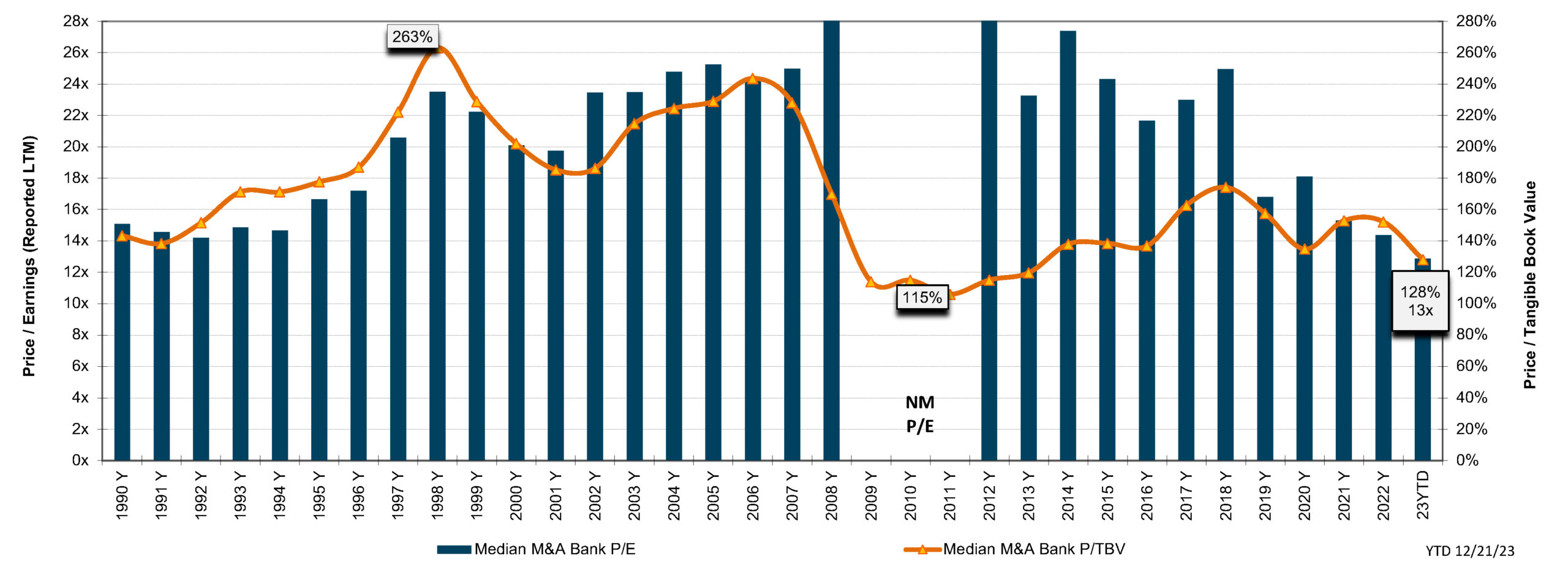
Source: S&P Global Market Intelligence
Click here to expand the image above
Source: S&P Global Market Intelligence
Click here to expand the image above
Public Market Multiples vs Acquisition Multiples
Figure 3 compares the annual average P/TBV and P/E for banks that were acquired for $50 million to $250 million since 2001 with the average daily public market multiple each year for the SNL Small Cap Bank Index. Among the takeaways are the following:
- Acquisition pricing in the pre-GFC years, as measured by P/TBV multiples, was comfortably above 250%.
- Since 2013, average P/TBV multiples approximated 160% to 180% until COVID struck in 2020.
- The reduction in both the public and acquisition P/TBV multiples since the GFC reflects a reduction in ROEs for the industry since the Fed adopted a zero-interest rate policy (ZIRP) other than 2017-2019 and 2022-2023.
- Since pooling of interest accounting ended in 2001, the “pay-to-trade” multiple as measured by the average acquisition multiple relative to the average index multiple has remained in a relatively narrow range of roughly 0.9 to 1.15 other than during 2009 and 2010.
- P/E multiples based upon unadjusted LTM earnings approximated 20x prior to 2019 but have trended lower since.
- Acquisition P/Es have tended to reflect a pay-to-trade multiple of 1.25 since the GFC but the pay-to-trade multiples are comfortably below 1.0x to the extent the pro forma earnings multiple is 6-9x, the result being EPS accretion for the buyer.
Premium Trends Subdued
Investors often focus on what can be referred to as icing vs the cake in the form of acquisition premiums relative to public market prices. Investors tend to talk about acquisition premiums as an alpha generator, but long-term performance (or lack thereof) of the target is what drives shareholder returns.
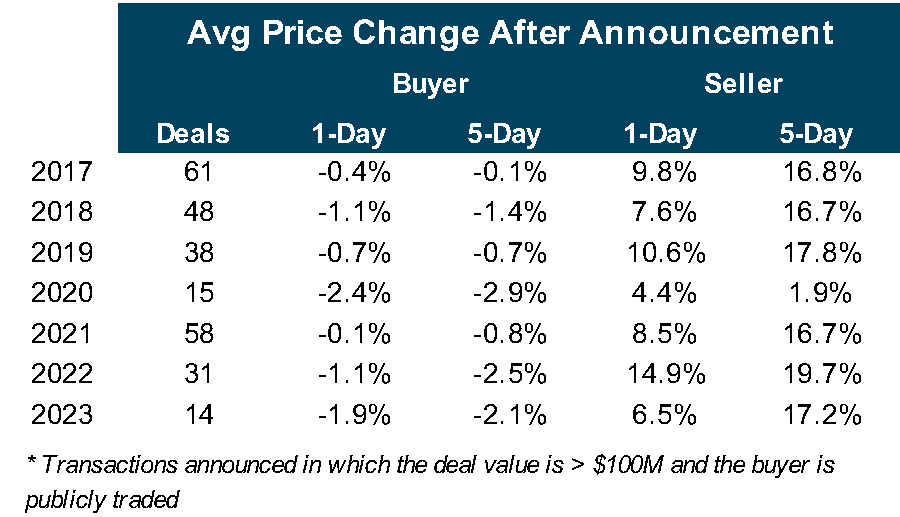
Source: S&P Global Market Intelligence
As shown in Figure 4, the average five-day premium for transactions announced in 2023 that exceeded $100 million in which the buyer and seller were publicly traded was about 17%, a level that is comparable to recent years other than 2020. For buyers, the average reduction in price compared to five days prior to announcement was 2.1%. There are exceptions, of course, when investors question the pricing (actually, the exchange ratio), day one dilution to TBVPS and earn-back period.
About Mercer Capital
M&A entails a lot of moving parts of which “price” is only one. It is especially important for would be sellers to have a level-headed assessment of the investment attributes of the acquirer’s shares to the extent merger consideration will include the buyer’s common shares. Mercer Capital has 40 years of experience in assessing mergers, the investment merits of the buyer’s shares and the like. Please call if we can help your board in 2024 assess a potential strategic transaction.

Source: S&P Global Market Intelligence
‘Twas the Blog before Christmas….
It has become a tradition for the RIA team at Mercer Capital to end the blog year with a “unique” annual summary of industry events, riffing off Clement Clark Moore’s classic “A Visit from St. Nicholas.” We hope all of you in the investment management community are enjoying the holiday season and looking forward to the many opportunities of the new year. We look forward to hearing from you in 2024. For now, please enjoy the finest only holiday poem written about money management.
Happy Holidays from Mercer Capital’s RIA Team!
‘Twas the night before Christmas, I sat at my desk,
Doom-scrolling news-feeds that left me distressed;
My stocking was hung, but I didn’t much care,
‘Cause I couldn’t make sense of this very strange year.
My colleagues were making their bets on the Fed,
Forecasting the next shoe to drop on their head;
Talking threats from inflation, the climate, and war,
And risks to this rally too hard to ignore.
Smart though they were, I just couldn’t listen,
A gloomy malaise had possessed my whole system;
So weary, was I, from emotional rout –
I drank all the scotch in my desk and passed out.
I dreamt that I saw a man rise from the mist,
Just like Adam Smith, the Scottish economist;
A ghost in an academic gown and a kilt,
Who could tout his free-market ideas without guilt.
His accent was thick, and hard to understand,
But he spoke of the market’s invisible hand;
How selfish ambitions help people worldwide –
And at that point he lost me, and so I replied:
“Invisible Hands? That sounds more like the knowledge,
That I tried on co-eds when I was in college.
Banks stocks have foundered, though real rates are falling –
The market says ‘Pivot,’ but Jay Powell is stalling.”
“Bitcoin, of all things, has really set sail,
In spite of Sam Friedman being locked up in jail;
Tech stocks are back, gold bears no relation,
To Mr. Market’s immaculate disinflation.”
“Great Scot!” cried the ghost, “how your thinking is primitive,
You’ve clearly ignored every second derivative;
Regulation has put bank returns out of reach,
But for now private credit is filling the breach.”
“That Covid pandemic caused such dislocations,
That we were at serious risk of stagflation;
The Fed, overall, handled this like a whiz,
But compared to Paul Volcker, Jay Powell has no rizz.”
“Equity prices are rewarding the faithful,
Term-premiums are back, and for that be grateful;
Above all, it’s Christmas, so be of good cheer,
You can’t say ‘23 wasn’t quite a good year!”
“Now go read my books if for learning you hunger,
I’m late for my dinner with friend Charlie Munger;”
But I heard him exclaim, as he faded from sight,
“Give markets a chance and they’ll settle things right!”
![]()
It’s Getting Real(ized)
As has been recently discussed by many, the significant rise in yields across the Treasury curve, with the most notable increase occurring at the short-end of the curve, has resulted in large unrealized losses in bank securities portfolios. From March 2022 through July 2023, the Federal Reserve increased the target Federal Funds rate eleven times for a collective increase of 525 basis points. Since the last 25 basis point increase in July 2023, the Federal Reserve has opted to hold the target Fed Funds rate steady.
To start, we provide an update of a data table we’ve included in prior versions of Bank Watch regarding unrealized losses in bank bond portfolios.

Unrealized losses in available-for-sale (“AFS”) designated portfolios range from an average of 8.3% for banks with assets greater than $250 billion to 12.4% for banks with $1 billion to $3 billion of assets and banks with $3 billion to $10 billion of assets. As a percentage of Tier one capital, the range was from 14.2% for banks with assets greater than $250 billion to 29.2% for banks with $100 million to $500 million of assets.
For additional perspective on the trend in bond portfolio losses, the following table depicts unrealized losses in AFS portfolios for 1Q22, 2Q22, 2Q23, and 3Q23. As shown below, the magnitude of losses has steadily increased for all banks since the Fed began raising rates in early 2022.
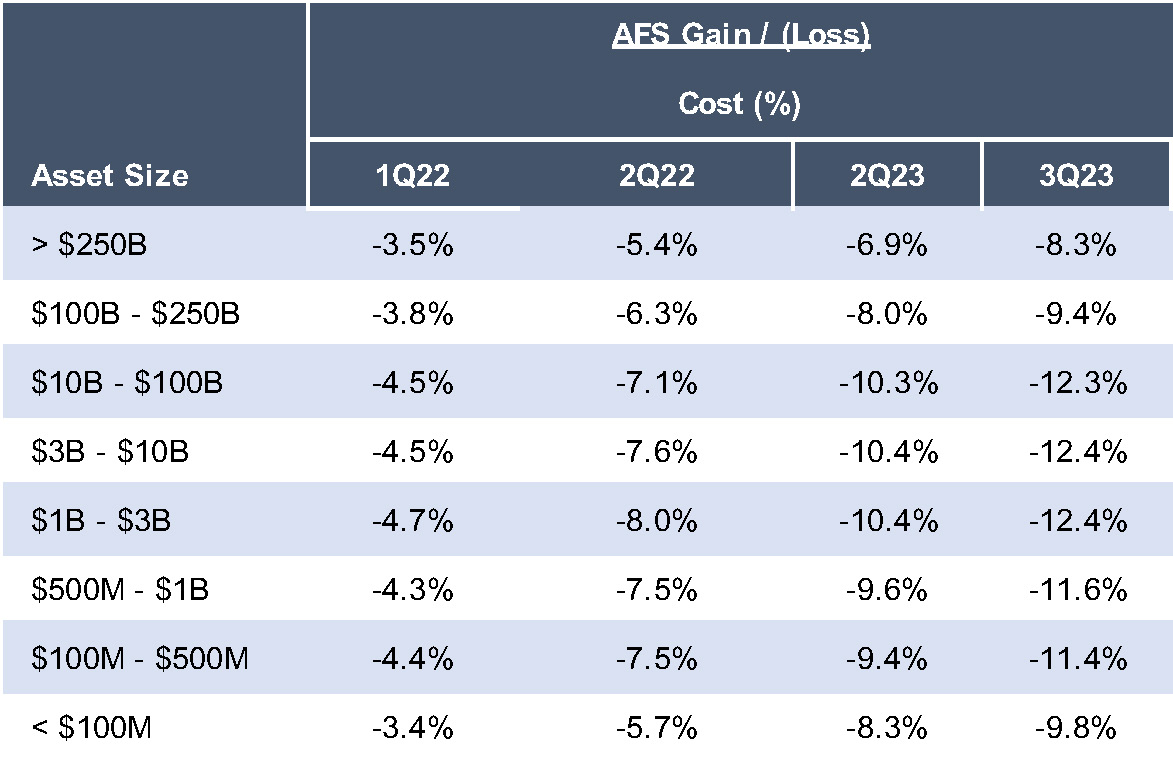
In our September publication of Bank Watch, my colleague Andy Gibbs covered some implications of a higher-for-longer rate environment. In discussing what banks should do with internally generated capital if the return on capital from more aggressive loan growth strategies is diminished, Gibbs wrote:
A more controversial strategy would entail using some excess capital to effectuate a partial restructuring of the bond portfolio. Rather than tying up capital with loans earning a relatively low spread over marginal funding costs, a bank could exit some low yielding investments at a loss that could be replaced with investments at current market rates (or used to pay down costly borrowings).
In the third and fourth quarters of 2023, securities portfolio restructuring is a strategy that appears to be gaining momentum. Mercer Capital reviewed regulatory, SEC, and various public filings for some of the banks that have announced such actions. In the following table, we’ve summarized some data points of interest for our sample of banks that elected to reposition the securities portfolio in the third or fourth quarter.
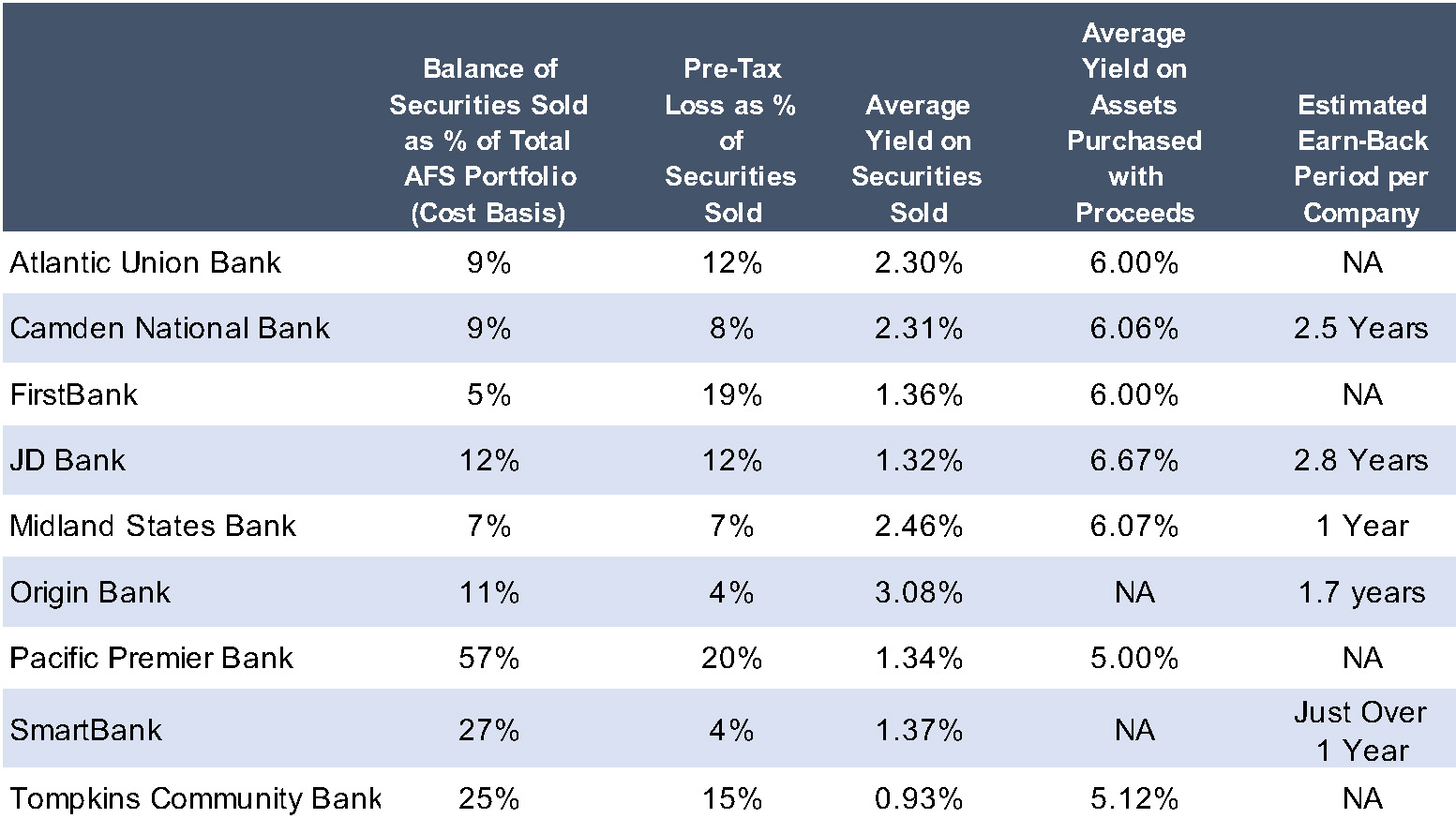
Unless rates decrease significantly, losses on securities will be realized in either of two ways: (i) immediately, through losses on sale or (ii) over time, through lower earnings. As illustrated in the table above, one of the potential pros of selling securities immediately is net interest margin enhancement, as proceeds from the sale of underwater securities can be reinvested in higher yielding assets. For the banks that reported the average yield on securities sold and the average yield on assets purchased with the proceeds from the sale, the pick-up in yield ranged from approximately 360 bps to 535 bps.
Another potential pro is the ability to repay high-rate borrowings with the proceeds, which is what OBK chose to do. After selling securities with an average yield of 3.08%, the proceeds were used to pay down outstanding FHLB advances with an interest rate of 5.62%. OBK noted an expected 11 bps pickup in its NIM from the trade. Other potential pros of selling underwater securities include reduced interest rate risk and closure of decisions made in a low-rate environment.
Banks undertaking bond restructurings expect accretion to shareholder value, as higher net interest income leads to higher earnings in 2024 and beyond which supports a higher stock price. In a perfectly efficient market, a bond restructuring should have no impact on a bank’s share price, as the market has already discounted the impact of low yielding bonds purchased in a different interest rate environment. But the market is not perfectly efficient.
In our sample, JD Bancshares, Inc., Tompkins Financial Corporation, and Pacific Premier Bancorp, Inc. are the only companies that announced the securities portfolio repositioning separately from earnings. Given limited trading volume for JDVB, we focused on the change in stock price for TMP and PPBI post announcement of the bond portfolio restructuring. From the day prior to the announcement to three days after, TMP’s stock price increased 2.0% and PPBI’s stock price increased 3.0%. For comparison, the S&P U.S. BMI Banks Index declined by 3.9% and 3.2% over the same time periods.
While there are certain benefits to a securities portfolio restructuring, there are also cons to consider. For one, banks must have adequate capital to be able to absorb the hit when previously unrealized losses are realized, and the impact to capital may not be tolerable for some banks. Furthermore, lower capital affects the potential size of the balance sheet, due to minimum capital ratios, and therefore affects earning potential. For example, a reduction in capital from a bond portfolio restructuring could constrain organic growth or M&A opportunities. Finally, beyond the traditional capital ratios, banks should be aware of the impact of a bond restructuring on the CRE loan/capital ratio, which has received greater regulatory focus.
Other potential disadvantages of selling underwater securities and repositioning the portfolio include investor/customer reaction and the uncertainty regarding future rates. Rates could decrease before the securities loss is earned back through higher net interest income. As shown in the table on page 2, the earn-back period in our sample ranged from 1 to 2.8 years, for the companies for which this metric was reported. Some compensation arrangements, if linked to reported net income, may be affected by a bond restructuring.
Finally, banks should monitor accounting developments. An argument exists that if bond sales occur as part of an integrated series of transactions this could result in all, or a significant share of, the available-for-sale securities portfolio being marked to market through earnings rather than shareholders’ equity.
Earn-Back Math
The earn-back period calculation appears simple—divide the equity impact of the bond portfolio restructuring by the after-tax earnings enhancement—but is subject to considerable discretion. Digging into the math of a bond portfolio restructuring reveals the following:
The pick-up in yield is not as simple as comparing the yield on the bond sold to the yield on the replacement bond. Assume a bank has a bond with a par value of $1,000 with a 2.00% rate, which it sells for $750. The bank receives $750 of cash that it can use to buy a new bond yielding 5%. The pick-up in income is not 3% (the difference between the 5% yield on the new bond and 2% on the old bond). Instead, the bank gives up $20 of income ($1,000 x 2%) and will earn $37.50 going forward ($750 x 5%). That is, the pick-up in income is only $17.50, which is much less than suggested by the spread between the yields on the new and old bonds.
The earn-back period is affected by the selection of bonds sold. Holding other factors constant, if a bank desires a short earn-back period, it should sell bonds with shorter durations (and lower losses on sale). Selling long-term bonds with higher losses will produce a longer earn-back period.
As an example, assume a bank is evaluating two bond portfolio restructurings. The first includes bonds with a 2% yield and a two year duration, while the second liquidates bonds with a 2% yield and a 20-year duration. The denominator in the earn-back calculation (the after-tax earnings enhancement) is likely to be similar in the near-term regardless of which scenario occurs. However, the first scenario would entail a lower loss on sale (which affects the numerator in the earn-back calculation), thereby producing a shorter earn-back period.
If your bank would like a second opinion on the merits of a potential bond restructuring, please contact a member of Mercer Capital’s Financial Institutions Group.
Coming Off the COVID Wave
Transportation and Logistics Industry | Third Quarter 2023
We’re sitting most of the way through 2023 at this point, and we are continuing to live in interesting times. The shipping frenzy brought on by the COVID-19 pandemic has run its course and the industry is returning to more normal levels. At the same time though, it is important to note that a decline from never-before-seen highs does not necessarily indicate a freight recession is underway. Many of the year-over-year data points will indicate large declines, but on a quarterly or monthly basis, the data is much more stable.
When looking at spot and contract pricing, It is easy to be concerned about the fall off of rates relative to the last two years. It is important to remember, as we will see later in this quarterly review, that spot and contract rates for all classes of freight remain materially higher than their pre-pandemic levels. Additionally, these rates have been stable for several months, with minimal changes in either direction. Markets are slightly soft heading into peak season, but are a far cry from previous recessions weathered by the transportation industry.
Other big news in the transportation world has been related to supply chain issues. The earlier option to offshore granted companies a larger, cheaper labor pool in East Asia at the expense of more complex supply chains with the potential for bottlenecks. Disruptions arising during the pandemic showed how risky the offshoring choice could be, as ships lined up by the dozens to offload cargo in Californian ports. In response, many carriers shifted their import handling to East Coast ports – with the port of Savannah being one of the biggest winners in the shuffle. Meanwhile, companies continue to reshore and nearshore their operations, with Deloitte estimating that over 40% of China-originating freight will shift to the Americas by 2029.
This drive to nearshore has been a boon for Mexico, which recently surpassed China as the U.S.’s largest trading partner. Mexico continues to work with U.S. officials and U.S. corporations to attract manufacturing to the country, and recent U.S. legislation has encouraged companies to reshore or nearshore. Both the return of manufacturing to closer shores and the shifting of cargo to East Coast ports have required transportation companies to re-orient their lanes and services.
And It is hard to wrap up a discussion of Q3 2023 without touching on the failure of Yellow. Yellow, previously the country’s third largest LTL provider, experienced financial difficulties throughout the pandemic boom and received a COVID loan of $700 million from the U.S. federal government. Yellow was highly levered and had nearly $1.3 billion in debt coming due in 2024. Yellow attempted to negotiate with the Teamsters, which represented over 70% of its workforce. When Yellow missed payments to a healthcare pension fund in July, the Teamsters issued a strike threat, which in turn caused many customers to look for other LTL carriers.
The full fallout from the Yellow bankruptcy is yet to be seen. The U.S. Treasury retains a 30% stake in Yellow’s equity and Apollo Global Management holds a significant amount of Yellow’s debt. Yellow’s fleet hitting the market should depress used and new trucking prices. The sudden exit of a large piece of the nation’s LTL capacity temporarily buoyed other LTL providers. Many of Yellow’s customers began contracting with other LTL carriers in the months before the announcement of Yellow’s bankruptcy, muting the immediate impact of the Chapter 11 filing.
The third quarter of 2023 has certainly been one for the books.
UPDATE: Analysis of the Spirit Fairness Opinions re the JetBlue Acquisition
Earlier this year, we published an analysis of the still pending acquisition of Spirit Airlines, Inc. (NYSE: SAVE) by JetBlue Airways Corporation (NASDAQGS: JBLU) focusing on the fairness opinions issued by Morgan Stanley and Barclays to the Spirit board in July 2022.
A Recap of Events:
- February 5, 2022 – Spirit agrees to be acquired by Frontier Group Holding, Inc. (NASDAQGS: ULCC) for 1.93 Frontier shares and $2.13 per share of cash for each Spirit share that at announcement equated to $25.83 per share ($2.9 billion).
- March 29, 2022 – JetBlue made an unsolicited offer of $33.00 per share of cash.
- May 2, 2022 – Spirit rejected JetBlue’s offer.
- May 16, 2022 – JetBlue commenced a $30.00 per share tender offer, noting that the tender price was less than the unsolicited offer because the Spirit board was “unwilling to negotiate in good faith with us.”
- July 27, 2022 – the Spirit-Frontier deal was terminated.
- July 28, 2022 – Spirit agreed to be acquired by JetBlue for a) $33.50 per share of cash, or $3.8 billion, with $2.50 per share payable upon approval of the deal by Spirit shareholders; b) a monthly ticking fee of $0.10 per share up to $0.65 per share commencing in January 2023; and c) $70 million termination fee if the agreement is terminated for failure to obtain regulatory approval.
As shown in the chart below, Spirit has not traded close to the $33.50 per share acquisition price since the deal was struck. The merger arbitrage community, in effect, has assigned a decreasing probability that the transaction will close, with the shares trading around $10 per share as of mid-November.
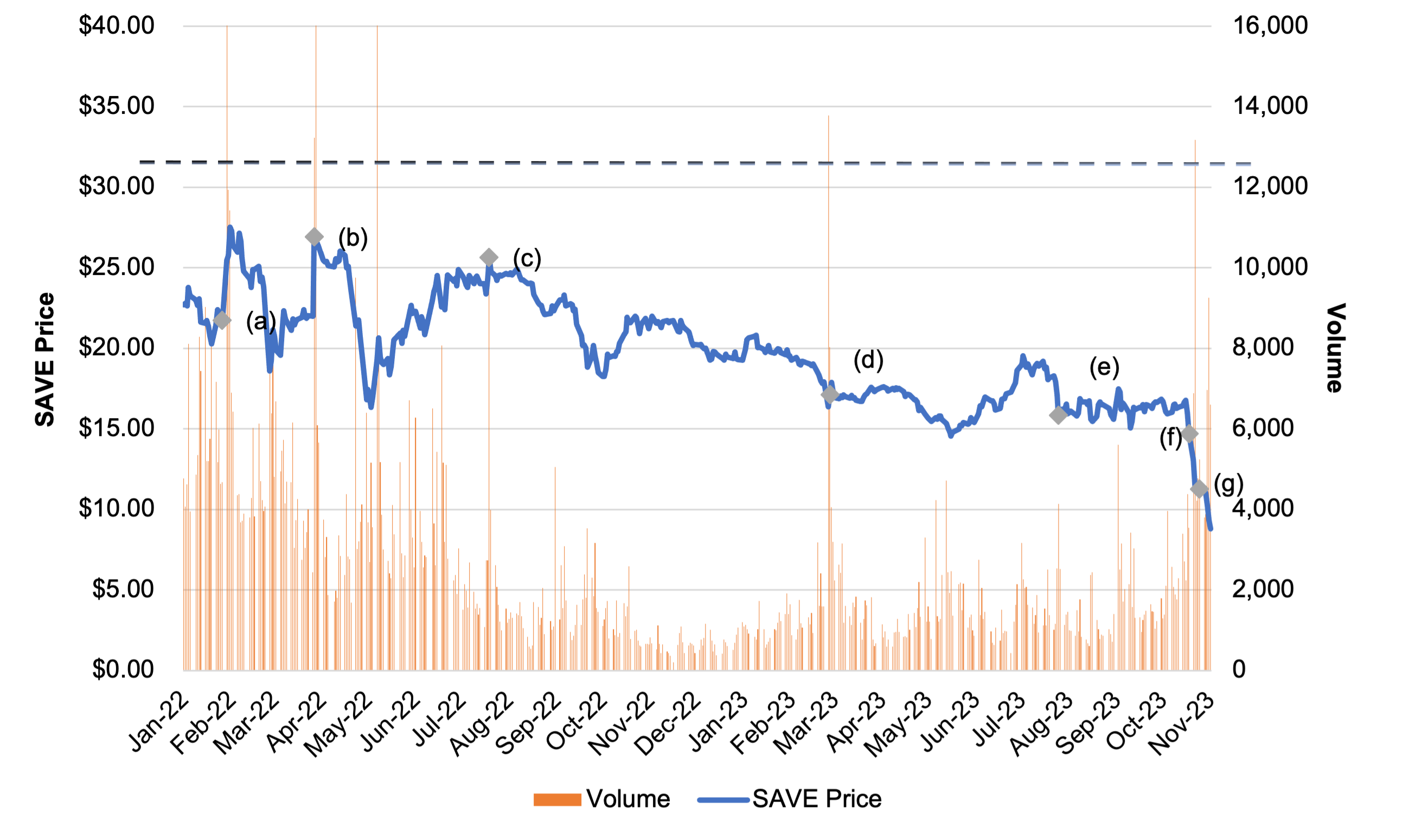

In our analysis earlier this year, we noted the valuation attributes and process the Spirit board followed made the issuance of the fairness opinions a straightforward proposition; however, we ended by asking the question if the Spirit board had adequately considered the possibility that JetBlue could close the deal.
At the time the Frontier deal was announced, some including Frontier expressed skepticism that JetBlue could obtain regulatory approval through anticompetitive considerations. While any airline transaction faces intense government scrutiny given the concentrated nature of the U.S. airline industry, a Frontier-Spirit combination was (is) viewed by many investors as more obtainable than JetBlue-Spirit, given relative market shares and routes.
To no one’s surprise, the Department of Justice sued on March 7, 2023, to block the JetBlue deal. The trial began on November 3, 2023. A ruling is expected before year-end.
In our prior post, we speculated that the Spirit board may have calculated that JetBlue was a risk worth taking because a) the offer was 30% greater than Frontier’s offer; b) JetBlue provided $400 million ($4.30 per share) of downside protection; and c) a jilted Frontier presumably would be willing to reengage Spirit if the JetBlue deal failed.
The still-pending JetBlue-Spirit deal illustrates the widely quoted maxim that time is the enemy of all deals. While the Frontier deal was not a sure thing, Spirit’s shares traded near the Frontier acquisition cash price during the first quarter of 2022; however, once the calculated risk of terminating the Frontier deal and agreeing to the JetBlue deal was accepted, the shares have traded steadily lower to around $10 per share as of mid-November 2023.
The downdraft reflects the assessment of the merger arbitrage community that the government will prevail to block the merger in its lawsuit against a backdrop of weakening industry fundamentals. Airlines in the second and third quarters of 2023 generally missed Street consensus estimates and gave downbeat assessments of operating conditions.
Spirit was not an exception, missing consensus estimates in both quarters and guiding sharply lower with the release of third quarter results. Aside from tougher industry conditions due to declining consumer (but not business) traffic, higher fuel costs, and ongoing ATC issues, Spirit warned that September results would be negatively impacted by the grounding of seven Airbus A320neo aircraft due to issues with certain Pratt & Whitney engines. With the release of third quarter results in October, the number of grounded aircraft was projected to be as high as 26.
Ironically, the grounding of aircraft by Spirit and worsening financial results may give JetBlue leverage to renegotiate a lower price or walk if the conditions are bad enough, assuming the company prevails in court by invoking the “material adverse event” clause in the merger agreement. If so, another round of litigation probably would occur.
Specialty Finance M&A
October was another sour month for bank investors. The KBW Nasdaq Regional Bank Index declined 6.5% through October 27 and is down 27.9% year-to-date. While the failure of SVB and Signature Bank in March caused bank stocks to nosedive into the end of the first quarter, the ~100bps lift in the yield in the 10-year UST note produced a similar result during September and October.
Not surprisingly, bank M&A activity remains muted, punctuated by an occasional transaction of note such as Evansville-based Old National Bancorp (NYSE: ONB) and Nashville-based CapStar Financial Holdings, Inc. (NASDAQ: CSTR) agreeing to merge in a stock-swap that valued CapStar at $346 million.
Acquirers’ shares trade at low multiples, and fair value marks of low-rate, fixed-rate assets are draconian. Plus, there is the capital “question” given an extended benign credit cycle and the gap between regulatory capital and core equity capital that is marked for unrealized bond losses. Nonetheless, the best deals (and loans) often are made during challenging times.
Like conventional bank deals, transaction volume for specialty finance companies is modest compared to recent years. More so than in recent years, activity can be described as tuck-in deals to introduce or augment a product offering, or opportunistic for distressed sales. Generally, bank acquirers have favored commercial finance over consumer finance lenders given challenging consumer compliance associated with auto finance and highly cyclical nature of mortgage banking.
As shown in the table below, there have been only five specialty finance deals involving a bank buyer announced since the beginning of the year compared to 13 in 2022 when rising rates sidetracked deal activity during the second half of the year. Prior to 2022 excluding 2020, a typical year would entail banks acquiring 20+ specialty finance companies per year according to S&P Global Market Intelligence.
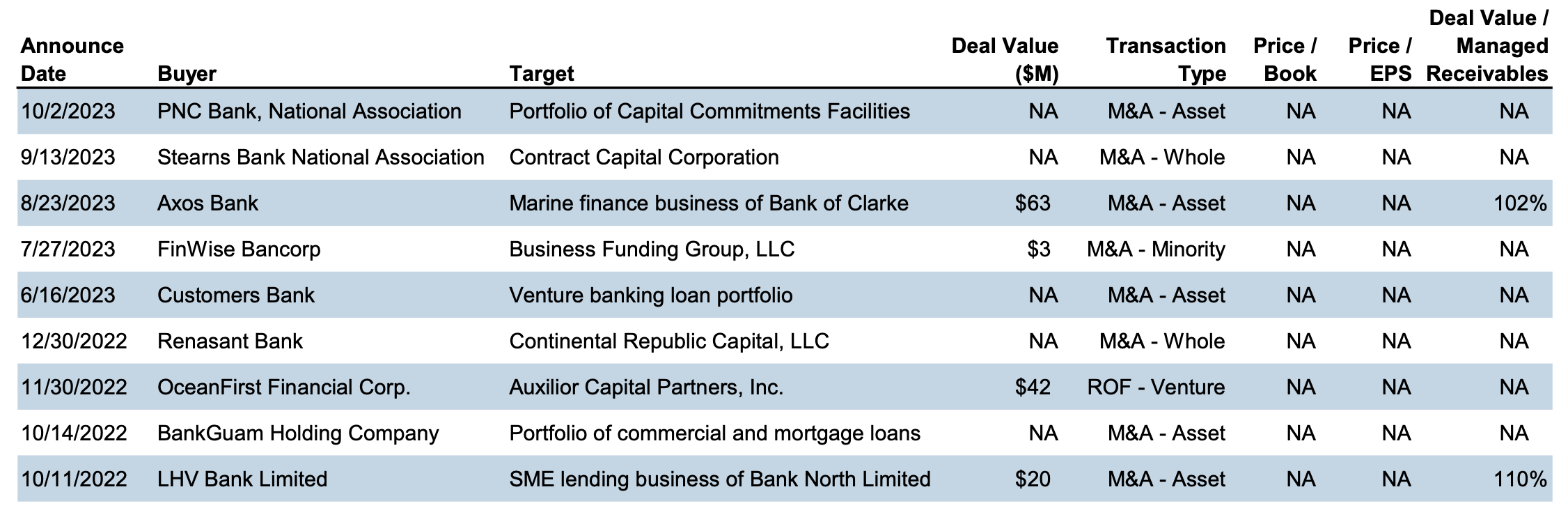
Click here to enlarge the table above
One of the more innovative transactions was a white label deal Synovus struck with Cincinnati-based Verdant Commercial Capital in July 2022 whereby Verdant will serve as the white label originator of equipment leases for Synovus Equipment Leasing. Synovus now offers equipment leasing of $25 thousand to $50 million to its clients through Verdant, which has expertise and execution capabilities that Synovus does not have. Synovus also provides lender finance to Verdant via a credit facility.
While the deal making environment is challenging, specialty finance acquisitions can be accretive to shareholders if structured and priced properly. Generally, the benefits we see are:
- High return on capital assuming the buyer does not overpay given the high(ish) yields most specialty finance companies produce when combined with low-cost bank deposit funding;
- Portfolio diversification, including a reduction in CRE exposure that is an issue with many banks;
- Cross sell opportunities, including establishing a deposit relationship; and
- Valuation arbitrage in which specialty companies often are valued at P/E multiples of 6-9x compared to 9-13x for commercial banks.
No acquisition comes without a unique set of risks. The following are some of the cons to a specialty finance acquisition:
- Credit risk in that specialty finance lender borrowers may be less well capitalized and more downturn sensitive than the “average” commercial bank customer with collateral often consisting of movable collateral vs real estate;
- Credit box risk in that executive bank management tightens the credit box too much and thereby weakens the business case for owning in the first place;
- Enterprise risk related to different processing and monitoring systems that may not be as robust as a bank’s;
- Integration risk due to cultural differences though this can be lessened to the extent the specialty finance company remains a separate subsidiary or division;
- Funding may be an issue if bank ownership tightens too much and thereby puts the unit at a competitive disadvantage.
Acquiring a specialty finance company comes with a unique set of hurdles, different than acquiring a bank. Cost synergies other than cost of funds usually are inconsequential. Buyers need to be aware of the target’s ownership structure and ensure that remaining managers (or key employees) upon close of the transaction are financially aligned with the bank’s goals.
While bank buyers should focus on the impact to capital, dilution to tangible BVPS and how quickly the dilution is recovered via EPS accretion, heavy consideration should be placed on the return on invested capital.
While the Street likes to focus on internal rate of return calculations in which much of the IRR is predicated upon a terminal value derived from a multiple of earnings, we think a simpler approach is how much money can the unit make compared to the capital outlay that encompasses all deal costs. If the return is sufficiently high, other metrics should be okay.
As for structuring a transaction, cash vs stock and how much consideration should be reserved for an earn-out are standard questions. The higher rate environment today makes each financing option more expensive in the form of shares that might be issued trade at modest multiples, while the cost of debt and opportunity cost of excess liquidity are high compared to several years ago.
Nonetheless, the more challenging operating environment for banks and non-bank lenders may lead to more attractive acquisition opportunities for banks with the capacity to engage in a transaction.
Opportunities for Ownership Succession in the Beer Wholesaler Industry
Has Your Beer Lost Some Fizz?
The last 6 to 18 months have been wrought with challenging economic and industry conditions. For many U.S. wholesalers (particularly ABI houses), a regression to lower pre-COVID sales volumes coupled with unprecedented brand disruption have contributed to a softening of sales and profitability. The narrative appears to vary more by brewery affiliation and territory than ever before.
According to the Brewers Association, U.S. beer sales volume continues its downward path with a decline of 3.1% in 2022. In 2022, the standard drink was more likely delivered in a cocktail glass rather than a beer mug – a consumer first, even if only slightly so. And an imported Mexican lager (Constellation’s Modelo Especial) now sits on the top shelf of U.S. beer sales replacing AB InBev’s Bud Light. Softening the decline from recent years’ performance has been consumers’ willingness to spend on premium labels and growing NA and RTD category products as well as higher pricing. But will a potential impending economic downcycle reverse some of this premiumization and put a stall on recent pricing patterns?
Wholesalers seeking a strategic exit may be facing tighter market valuations. But the downside in previously robust transaction trends may represent a silver lining for wholesalers needing to achieve overdue ownership succession and favorable estate planning objectives.
Mercer Capital’s experience in the industry prompts us to alert our clients and friends in the beer distribution space to several marketplace realities that are currently exerting downward pressure on the fair market value of many distributorships.
Our message to readers – take advantage of current market conditions to enhance the outcome of your ownership succession and estate planning strategies.
What’s Causing Valuations to Decline?
We discuss several considerations and developments that are currently influencing valuations in the industry. Note that only an experienced valuation practitioner in the space understands how these trends and expectations are properly quantified in a valuation.
Interest Rates
Some of us are happy to see the yield on certain of our investment holdings improve in this environment of elevated interest rates. But, if you are paying these rates on your past capital expenditures and acquisitions, the current rates are painful.
Higher interest rates increase the cost of capital used in business valuations. The higher the cost of capital, the lower the value of the business.
Other things held constant in the business valuation equation, the increase in interest rates beginning in early 2022 suppressed equity valuations by 20%-30% in many industries and the effects continue to burden valuations in 2023.
Of course, there are exceptions, particularly for certain wholesalers who have benefited from the current market share upheaval and higher product pricing. Fair market value and strategic value remain potentially quite different for many wholesalers. Regardless, no one is immune to the value suppressing force of higher interest rates.
Inflation and Pricing
As suppliers adjust their prices, wholesalers reprice to the retail tier. The dynamics for many in recent years resulted in higher pricing growth than volume growth. For many wholesalers, catch-up pricing in 2022 offset volume declines, which has netted to relatively modest growth in overall sales in the recent period.
Price-motivated growth eventually succumbs to the laws of gravity. Beer and other consumer discretionary products are competing against higher prices for consumer essentials (housing, food, and fuel) potentially leaving less purchasing power for product premiumization and leisure consumption in general.
Share of Mouth
Apparently, “joe six-pack” became “johnny cocktail” in 2022. Twenty years ago, preference for beer among alcohol drinkers was almost twice what it is now. Spirit-based RTDs aren’t helping matters as consumer choice expands and competing suppliers leverage their brands to siphon off tradition beer drinkers.
Category Diversification
Beer wholesalers are expected to continue augmenting their portfolios with various non-alcoholic products. Margins for these products typically fall short of the beer portfolio. Additionally, these suppliers are not subject to the same regulatory oversight as alcoholic beverage suppliers, making such volumes risker to the wholesaler and less valuable in the marketplace.
We have seen many wholesalers invest heavily to grow a product and then suffer the loss of a supplier due to upstream consolidation or realignment.
If 10%-30% of your volume is worth half as many turns of gross as your legacy beer portfolio, that can have a material effect on your whole-house valuation. These dynamics fall on top of the increased warehouse shelf and isle space called for in an ever-increasing world of SKUs.
Demography and Migration
The benefits of high density in population and account proximity are reduced when drinkers spread throughout or exit your territory and volumes are delivered at the fringe of your territory versus the geographic core of your market.
The distance each CE moves to find its retail home has a bearing on your two most labor-intensive activities (selling and delivery).
A 1% change in the margin structure of your business can easily represent 10%-15% of your total business value.
Other Issues
The alcoholic beverage distribution industry has many specific concerns. But the pains of the industry are compounded by the same fears and challenges facing all business owners.
Operating costs for labor, roughly 50% of total operating expenses in the middle tier, haven risen dramatically in recent years. Finding qualified staff remains a challenge amidst strong labor markets and low unemployment.
Macroeconomic fears of an impending downturn in the economy in 2024 remain as weak housing markets and inverted yield curves are generally leading indicators of recession. These industry and macroeconomic factors may be further complicated by realities on the ground in your territory.
The Impact of High Interest Rates on the Rule of Thumb
We all know of the prevalence of rules of thumb based on supplier gross profit. Confusion reigns as it always has regarding the translation of supplier multiples based on brand growth, territory population, and logistical efficiency.
Rules of thumb are dangerous and typically do not apply across the differing scenarios under which a valuation may be developed. A standalone going concern premise under fair market value can be quite different than a valuation resulting from an actual business combination where territories are combined, and overhead expenses are rationalized.
Having qualified the issues with rules of thumb – what influence do high interest rates currently have on gross profit multiples?
Taking into consideration the complications of inflation and interest rates, portfolio valuations are potentially down 15%-20%, and potentially down further for market share losers suffering from the current AB InBev calamity and flat to modestly down for houses that gained share from ABI. Actual M&A results can vary based on the unique motivations of specific buyers and sellers. What deals do happen in the currently weakened borrowing environment are likely the result of special circumstances and unique motivations.
The Takeaway
For those wholesalers contemplating succession, now is the time to act.
Under current conditions, wholesalers with depressed market share and/or increasingly diverse NA portfolios could see a material reduction in their valuations. In addition, wholesalers who have persevered through recent years to emerge stronger are still subject to the realities of high interest rates so it’s wise not to delay.
And for those distributors who might see value increases, higher interest rates and the eventual new norms of post-pandemic market patterns are still likely to influence your valuation.
Regardless of your succession strategy, a common requirement in the succession process is obtaining a business valuation. Many business appraisers can lay claim to having valued a beer distributorship at one time or another. But few have performed scores (I’m losing count at 30 years of advisory practice) of valuations for scores of alcoholic beverage distributors in over 20 states.
If you are interested in understanding how Mercer Capital’s beverage industry expertise can help you achieve a viable plan of succession, please call or email to discuss your situation.
Navigating Complex Business Valuation in Litigation | Part 2: Strategies for Multiple Valuation Dates & Opposing Expert Reports
This is the second of a two-part series where we focus on navigating business valuation complexities in litigation. Part 1 discussed strategies for multi-entity and multi-location businesses and can be found here.
Case Scenario 3: Multiple Valuation Dates
In litigation, it is not uncommon for multiple valuation dates to be involved due to various events that cause the need for valuations. These different valuation dates present unique considerations. The need for multiple valuation dates can be triggered by a number of different reasons. Some states require date of valuation at separation or filing, while others require a current valuation as close to trial as possible. Multiple valuation dates may also be necessary in matters where the business began prior to marriage to assist in pre-marital or separate divisible value, as well as appreciation in value of the business during the course of the marriage and/or after separation through the current date. Some strategies when dealing with multiple valuation dates include:
- Understanding Changes in Circumstances: Valuing a business at multiple points in time necessitates a thorough understanding of how changes in the business between valuation dates can impact its value. These changes can shift the business’s financial performance, as can changes in the economic environment or industry that the company operates in. Example considerations include the following: Does the Company still pay rent expense to a third party, or do they now own the facilities of the business? Has the dividend policy changed over time? Has the industry the business operates in grown over time or has it hit a non-recurring peak in between valuation dates? Has the market share of the business changed and are the products & services offered from the Company still the same?
- Consistency in Methodology: Clearly document the valuation methodologies used at each valuation date and explain why you chose specific valuation approaches. If applicable, provide the rationale for any changes in methodology between the valuation dates. Ensure that the chosen methods are appropriate for the specific circumstances at each date. One factor that can impact a change in methodology is the life stage of a business. A younger company might be valued more appropriately by applying a discounted cash flow (DCF) method with increased growth and risk factors. On the other hand, a mature company at a later valuation date might be best valued using a capitalization of earnings method, a historical income approach with more moderate ongoing growth.
- Documentation of Changes: It is important to document and explain any changes in the business’s circumstances or assumptions that occurred between valuation dates. Maintaining a detailed change log that records significant changes in the business’s operations, financials, and market conditions can be helpful. For expert testimony, prepare your valuation expert to provide clear and credible testimony regarding the reasons for changes in circumstances and assumptions between valuation dates.
Case Scenario 4: Opposing Expert Report
When faced with an opposing expert report, it is necessary to assess the methodology, assumptions, and conclusions presented.
- Review and Analyze: Reviewing and analyzing the opposing expert’s report is the first step. Understand the valuation methods employed by the opposing expert and whether they have used the appropriate approach for the specific business and context. For instance, assess whether he or she has chosen an income-based, market-based, or asset-based approach and evaluate the appropriateness, provided facts and circumstances. Did the opposing expert give reasons for methods used and reasons for methods excluded or not relied upon? Did the opposing expert provide rationale for assumptions chosen through the report?
- Identify Weaknesses: Evaluate the reliability and relevance of the data sources utilized by the opposing expert. Assess whether the opposing expert has used outdated or inaccurate data. Delve into the key assumptions made by the opposing expert and identify if any of the assumptions used are unsupported or unrealistic. This could involve assumptions related to revenue growth, cost projections, discount rates, or market trends. Scrutinize the calculations and mathematical procedures applied in the report. Errors in calculations can undermine the reliability and accuracy of the valuation.
- Prepare for Trial: Once you have identified the weaknesses and inconsistencies in the opposing expert’s report, it is time to prepare for trial. Refute unsupported assumptions with evidence-backed data or industry benchmarks. Collaboration between the valuation expert and legal counsel helps both professionals prepare for trial.
Conclusion
Navigating business valuation complexities in litigation involving multiple valuation dates and opposing expert reports can be challenging. However, these challenges can be overcome through the strategies presented above. The ability to adeptly address complexities within multiple valuation dates and opposing expert reports are essential in the resolution of complex business disputes.
Additional resources to help you navigate through additional business valuation complexities in litigation are listed below.
ADDITIONAL RESOURCES
Twitter (X Holdings I, Inc.) Solvency
Exploring the issuance of a solvency opinion for the October 2022 acquisition of Twitter, Inc. by Elon Musk’s X Holdings I, Inc.
This short presentation is intended to discuss the concept of corporate solvency, solvency opinions and provide perspective on what issues a solvency opinion might address regarding the October 27, 2022, acquisition of Twitter, Inc. (“Twitter”) by Elon Musk’s X Holding I, Inc. (“XHI”). Since then, the entities have been renamed X Holdings Corp., which in turn wholly owns X Corp. that operates “X” previously known as Twitter.
In addition, the presentation makes observations about the financial performance of Twitter and the financing structure employed by XHI.
This Interest Rate Environment Done Got Old
One of BankWatch’s favorite blues artists is Junior Kimbrough. In “Done Got Old,” Junior sings:
Well, I done got old
Well, I done got old
I cain’t do the thangs I used to do1
You could say the same about this interest rate environment. Earlier in 2023, markets were expecting Fed rate cuts by late 2023; alas, this expectation missed the mark. Now though, as a higher-for-longer rate environment descends on the industry, perhaps banks cain’t do the thangs they used to do in a lower rate environment.
We had the good fortune to speak at Bank Director’s Bank Board Training Forum in Nashville earlier in September. Our presentation, Valuation Issues Post-SVB, focused on issues emerging from a higher-for-longer environment. Right on cue, the Wall Street Journal published an article entitled, “Higher Interest Rates Not Just for Longer, but Maybe Forever” arguing that the “neutral” interest rate that balances inflation and unemployment has risen.2
This article covers some implications of a higher-for-longer rate environment included in our conference presentation:
- Funding Costs and Net Interest Margins
- Growth & Capital Planning
- Securities Portfolio Management
- Credit Quality Risks
- Mergers & Acquisitions Impact
Funding Costs & Net Interest Margins
For many banks, a higher-for-longer rate environment is quite favorable, though sometimes media reports dwell on banks squeezed by rising rates. Figure 1 compares net interest margins between the first quarter of 2022 and the second quarter of 2023. We included the first quarter of 2022 as the impact of rising rates was minimal, PPP fee income had largely been recognized in prior quarters, and balance sheet composition reflected the changes that occurred during the pandemic. Our research indicates that 68% of the 2,764 banks included in the analysis reported a wider net interest margin in the second quarter of 2023. Many banks, in fact, face greater exposure to a long-term low rate environment than the current rate environment.
Figure 1
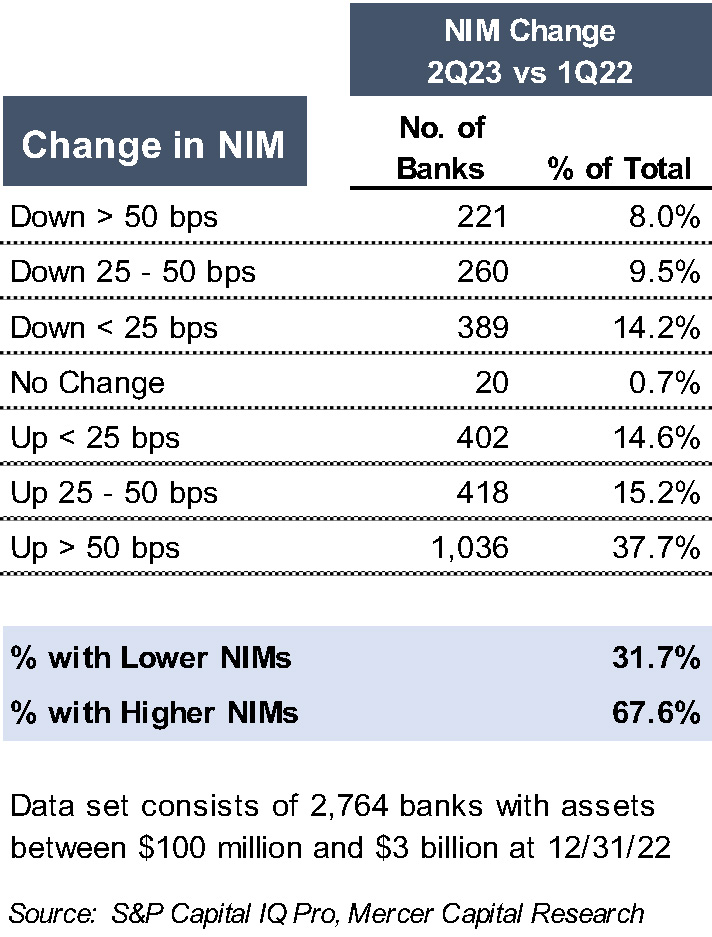
The most recent period in which the Fed Funds target rate exceeded 5% occurred from 2006 to 2007. As shown in Figure 2, the median cost of interest-bearing deposits for the same group of banks included in Figure 1 reached 3.75% in the third quarter of 2007. For the second quarter of 2023, however, this group’s cost of interest-bearing deposits was only 1.59% (see Figure 3).
Figure 2 :: 2006-2007 Cycle
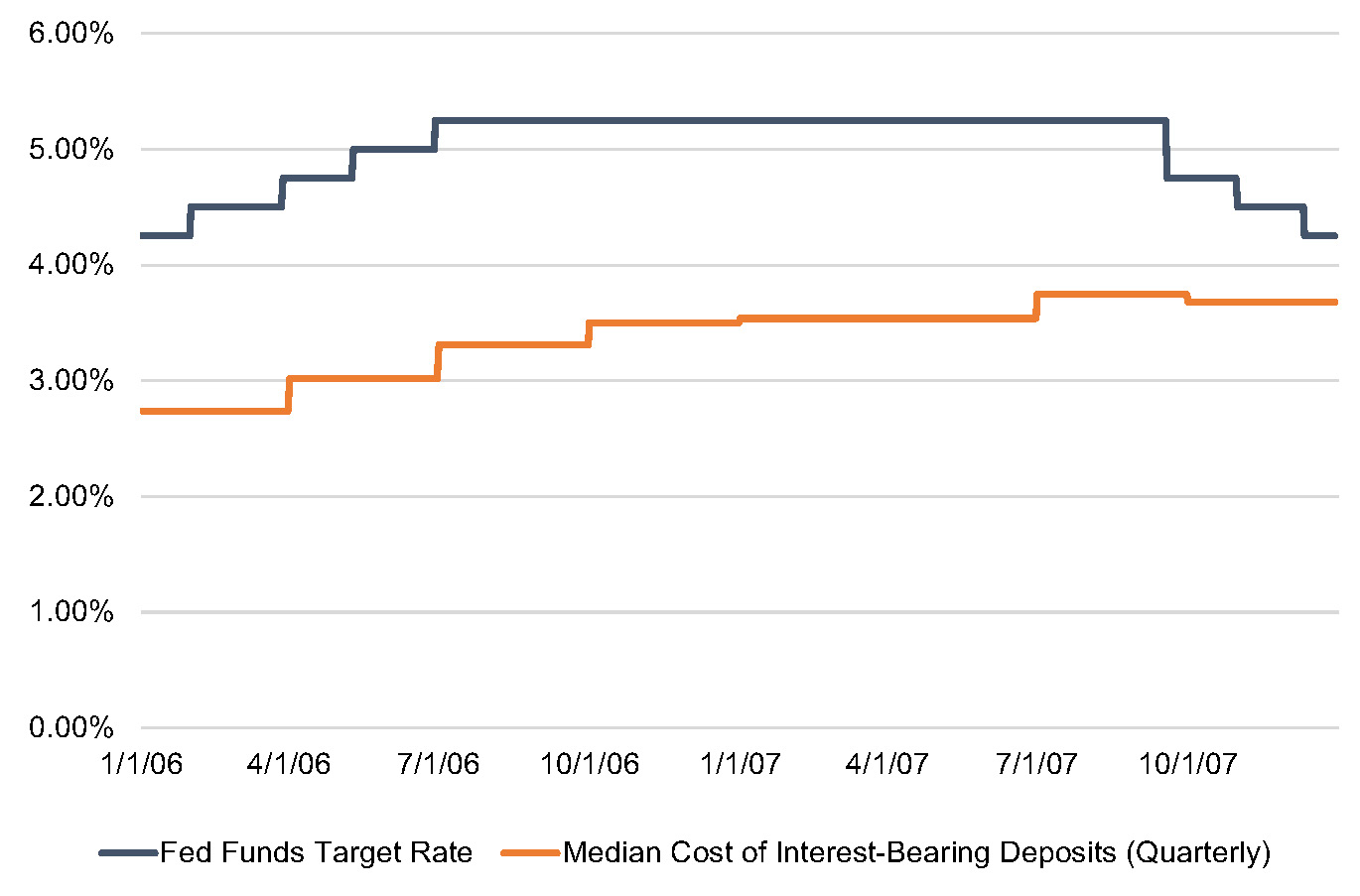
Figure 3 :: 2022-2023
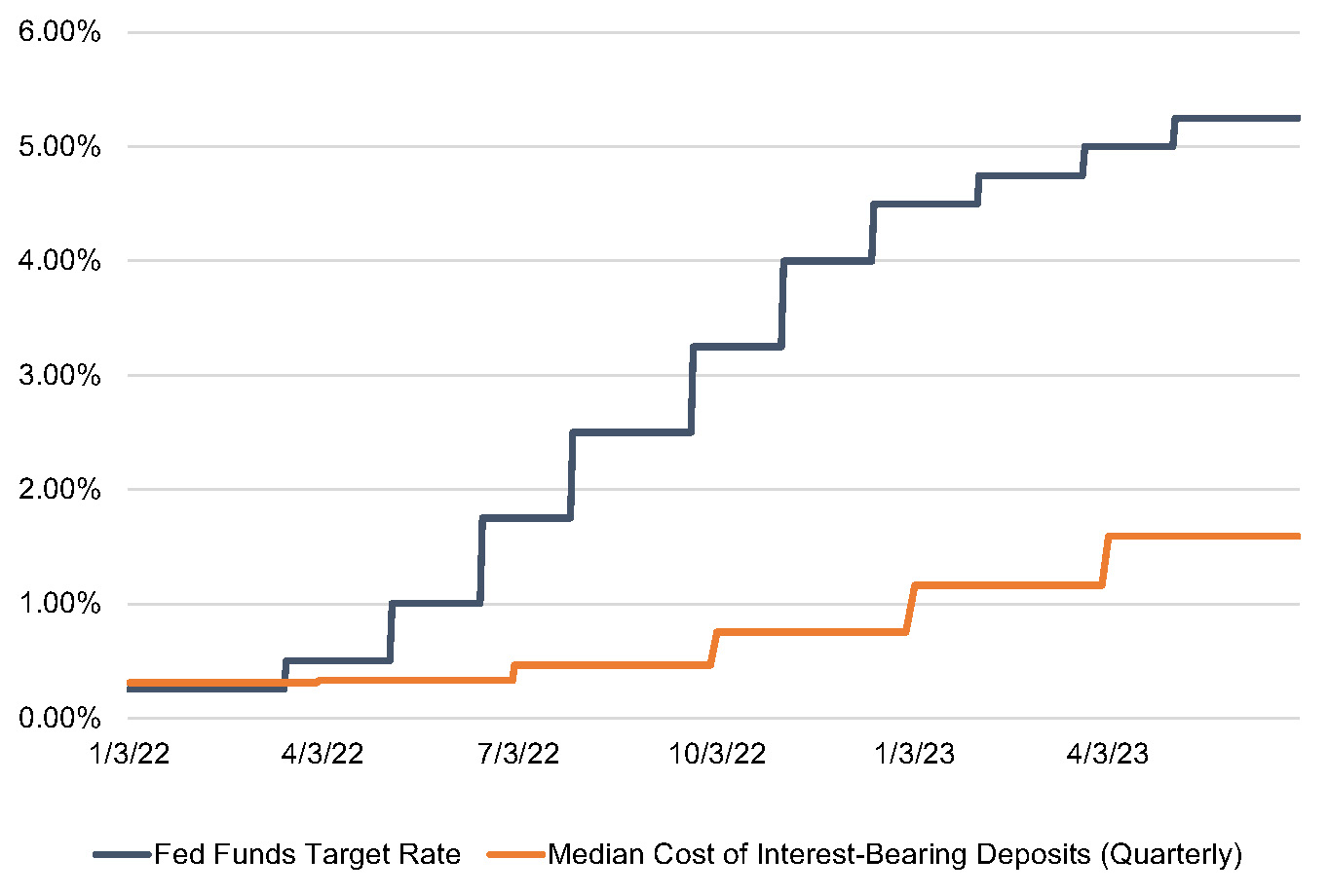
Deposit rates presumably will grind higher, and an extrapolation of recent deposit cost changes suggests that the median cost of interest-bearing deposits will reach 2.00% to 2.50% from 1.59% in the second quarter of 2023. Nevertheless, deposits cost for most banks likely will remain well below the level reported in 2006 and 2007. This is desirable for several reasons, but most importantly because earning asset yields are well below the level reported in 2006 and 2007. In the fourth quarter of 2007, the median yield on earning assets was 6.99%, which is 237 basis points higher than in the second quarter of 2023 (per Figure 4).
From an investment standpoint, current conditions somewhat mirror the late 1970s when most thrifts and some banks were caught with long(er) duration assets as funding costs rose. We believe the “asset duration issue” has weighed on bank stocks this year though institutional investors’ focus may now be shifting to credit risks.
Figure 4
Growth & Capital Planning
During periods marked by low rates, banks’ strategic plans often were oriented around loan growth, especially during the pandemic when banks were flush with deposits. This strategic direction, in turn, often was implemented by hiring loan officers or entering new markets. In a higher-for-longer rate environment, do these strategies remain appropriate?
A loan-oriented growth strategy certainly remains defensible for those banks that still hold substantial liquidity at the Federal Reserve. For other banks, though, the question becomes more complex. To measure the profitability of loan growth, banks should use their marginal cost of funds, not their current average cost of funds. Hiring an investor commercial real estate lender may be difficult to justify when the marginal cost of funding is 5%, as every loan originated by the new lender may compress the net interest margin. Other financial or strategic motivations could support such loan growth strategies—like obtaining long-term customer relationships or locking in an attractive loan yield supported by prepayment penalties–but bank directors should be aware of the return on capital implications of more aggressive loan growth.
During a higher-for-longer rate environment, balance sheet growth will be governed mostly by a bank’s ability to obtain funding at a reasonable cost. And we know that building core deposits takes time. Given these constraints, bank directors should temper their expectations regarding balance sheet growth. Individuals possessing strong deposit customer relationships or access to specific deposit niches will become more valuable traits in new hires (or more subject to poaching by other banks).
If the return on capital from more aggressive loan growth strategies is diminished in a higher-for-longer rate environment, what should banks do with internally-generated capital?
If the bank’s stock is trading at 8x to 10x earnings, share repurchases seem attractive (subject to one’s outlook regarding the probability of credit deterioration).
A more controversial strategy would entail using some excess capital to effectuate a partial restructuring of the bond portfolio. Rather than tying up capital with loans earning a relatively low spread over marginal funding costs, a bank could exit some low yielding investments at a loss that could be replaced with investments at current market rates (or used to pay down costly borrowings).
Banks could analyze which strategy produces a better return on capital. We will explore this issue in a future article, but suffice to say as the spread over marginal funding costs for new loans declines, enhancing earnings by “investing” some capital in a bond portfolio restructuring looks financially more appealing.
Issuers of subordinated debt may wish to accumulate funds to repay these instruments when the current rate resets after five years, rather than face an interest rate hundreds of basis points higher than the current fixed rate.
Securities Portfolio Management
As rates linger at a higher level, more banks will experience a low or negative spread on their securities portfolios, which we measure as (a) the yield on securities minus (b) the cost of earning assets (interest expense divided by average earning assets). Figure 5 presents a stratification of banks’ securities spreads based on data for 2,764 banks with assets between $100 million and $3 billion.
The number of banks with low or negative securities portfolio spreads has steadily increased. The proportion of banks with spreads of less than 1% increased from 8% in the fourth quarter of 2019 to 36% in the fourth quarter of 2022 to 43% in the second quarter of 2023. Similarly, banks with negative spreads increased from 2% in the fourth quarter of 2019 to 3% in the fourth quarter of 2022 to 7% in the second quarter of 2023.
Figure 5

As hope diminishes that the unrealized securities losses will quickly reverse and the earnings drag from securities with low (or negative) spreads continues unabated, banks will face a reckoning. The currently unrealized losses will be recognized in one of two ways: immediately through sale of securities or over time through lower earnings. Choosing between those two options, whether consciously or not, becomes unavoidable in a higher-for-longer rate environment.
Credit Quality Risks
Credit quality has remained remarkedly strong, except for some sectors for which most community banks have limited exposure like lower credit score consumer lending and central business district office properties. Our research found that 61% of publicly traded banks with assets between $1 and $10 billion reported lower criticized loans (i.e., loans rated special mention or worse) at June 30, 2023 than at year-end 2022. Nevertheless, some issues may arise in a prolonged environment of higher rates:
- Vintage Migration. The risk of higher interest payments affecting borrower performance as repricing or maturing fixed rate loans adjust to current loan rates has been cited as a risk, albeit an unrealized one so far for most of our clients. However, a higher-for-longer rate environment means that more lower rate loans in banks’ portfolios eventually will be ensnared by higher rates. The 2020 and 2021 vintage originations, when loan rate competition was most aggressive, would be subject to the greatest payment shock upon maturity or repricing. A large portion of the 2020 and 2021 vintages will not begin repricing until at least 2024 or 2025—time will tell how these vintages perform with higher loan rates.
- Problem Asset Carrying Costs. During the Great Financial Crisis, the cost of carrying nonperforming assets—the foregone yield on nonaccrual loans or the interest cost associated with carrying other real estate owned—exacerbated loan loss provisions and OREO write-downs. The erosion of operating income as nonperforming assets increased often tipped banks into a position of needing to raise capital (or worse). However, these carrying costs occurred in a low rate environment.
In a high rate environment, these costs would be amplified. OREO of $1 million may have incurred an interest charge of $10,000 during the Great Financial Crisis; now that charge could be $50,000. Stated differently, it would require fewer nonperforming assets in the current rate environment to produce the same erosion of earning power as experienced in the Great Financial Crisis. - Cap Rates. CBRE’s quarterly commercial real estate cap rate study indicates that cap rates, while rising from 2021 levels, are not much different from levels reported between 2012 and 2019.3 This implies, of course, a tighter spread between cap rates and 10-year Treasuries. A higher-for-longer rate environment, particularly if the 10-year Treasury continues its recent rising trend, portends higher cap rates that could pressure valuations for commercial real estate properties serving as loan collateral.
- Capital Augmentation through Securities Sales. In the Great Financial Crisis, banks had a sort of “Fed put” where falling rates created gains on securities, which in turn plugged capital holes created by credit losses. That cushion protecting banks from dilutive capital raises or forced M&A transactions is unlikely to exist, even if rates decline to some extent from current levels given the low coupons on bonds purchased in 2020 and 2021.
Mergers & Acquisitions Impact
Bank M&A activity improved in August 2023, although from a low base in prior months. Several factors likely prompted this, including more visibility into the extent of deposit attrition and the trend in deposit interest rates. Additionally, the balance sheet marks that are necessary to complete a transaction are becoming more accepted by both buyers and sellers.
Beyond credit, several other considerations exist for M&A transactions in a higher-for-longer rate environment:
- Deposit due diligence. Due diligence in the past often has focused on credit risk and compliance. The current environment suggests a greater need for diligence around the deposit portfolio, such as regarding accounts with larger balances, accounts held by larger shareholders, and the volatility in balances over different periods.
A merger and the related conversion process often trigger customers to reassess long-term relationships. A buyer should assess the sensitivity of the deal valuation to deposit attrition that differs from the target’s historical norm. In low rate environments, an unexpected loss of deposits usually could be replaced by wholesale borrowings without materially affecting anticipated earnings. In a higher rate environment, though, this cushion does not exist. The unexpected attrition of low cost deposits could materially erode the target’s expected earnings contribution, given the current variance between core deposit and wholesale funding costs.
- Merging banks with divergent deposit costs, particularly if the target’s deposit costs exceed the buyer’s deposit rates. Will the market penalize the buyer for a transaction that materially increases the buyer’s cost of funds? If the buyer attempts to migrate the target’s (higher) deposit rates to the buyer’s (lower) deposit rate structure, the buyer risks losing deposits and facing the need to replace them with even costlier wholesale funds. If the buyer leaves the target’s deposit rates alone, though, will it cannibalize its own deposits? That is, will the buyer’s existing low cost deposits migrate to the higher rates offered to the target’s depositors? This risk may be easier to manage in out-of-market transactions than in-market transactions.
Conclusion
As indicated in Figure 1 at the beginning of this article, many banks continue to perform quite well in this rate environment despite occasional expressions of doom in some media reports. Hopefully, not too many banks will be singing the blues like Junior Kimbrough as this high rate environment persists.
